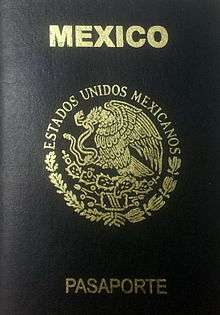Demographics of Mexico
With a population of about 126 million in 2019,[3] Mexico is the 10th most populated country in the world. It is the most populous Spanish-speaking country and the third-most populous in the Americas after the United States and Brazil.[4] Throughout most of the twentieth century Mexico's population was characterized by rapid growth. Although this tendency has been reversed and average annual population growth over the last five years was less than 1%, the demographic transition is still in progress, and Mexico still has a large cohort of youths. The most populous city in the country is the capital, Mexico City, with a population of 8.9 million (2016), and its metropolitan area is also the most populated with 20.1 million (2010). Approximately 50% of the population lives in one of the 55 large metropolitan areas in the country. In total, about 78.84% of the population of the country lives in urban areas, meaning that only 21.16% live in rural areas.
| Demographics of Mexico | |
|---|---|
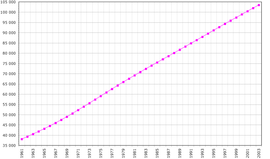 Population of Mexico, 1961–2003 | |
| Population | ca. 123 million |
| Growth rate | 1.9% (2015)[1] |
| Birth rate | 18.3 births/1,000 population (2016 est.) |
| Death rate | 5.8 deaths/1,000 population (2016 est.) |
| Life expectancy | 76.66 years |
| • male | 73.84 years |
| • female | 79.63 years (2012 est.) |
| Fertility rate | 2.4 children born/woman (2018) [1] |
| Infant mortality rate | 16.77 deaths/1,000 live births |
| Net migration rate | -1.64 migrant(s)/1,000 population (2014 est.)[2] |
| Age structure | |
| 0–14 years | 27.8% (male 16,329,415/ female 15,648,127) |
| 15–64 years | 65.5% (male 36,385,426/ female 38,880,768) |
| 65 and over | 6.7% (male 3,459,939/ female 4,271,731) (2012 est.) |
| Sex ratio | |
| Total | 0.96 male(s)/female (2011 est.) |
| At birth | 1.04 male(s)/female |
| Under 15 | 1.05 male(s)/female |
| 15–64 years | 0.94 male(s)/female |
| 65 and over | 0.81 male(s)/female |
| Nationality | |
| Nationality | Mexican |
| Language | |
| Spoken | Spanish, Zapotec, Nahuatl, Arabic, Mixtec, Purépecha, English, Tzeltal, German, French, Chinese, Italian and many others are also spoken varying by region |
The Census Inegi in Mexico is the Instituto Nacional de Estadística y Geografía (INEGI). The National Population Council (CONAPO), is an institution under the Secretary of the Interior in charge of the analysis and research of population dynamics. The National Commission for the Development of Indigenous Peoples (CDI), also undertakes research and analysis of the sociodemographic and linguistic indicators of the indigenous peoples
Demographic dynamics
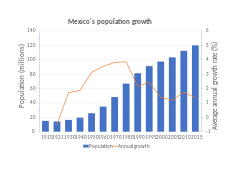
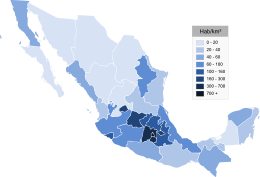
| Year | Pop. | ±% |
|---|---|---|
| 1865 | 8,259,080[5] | — |
| 1910 | 15,160,369 | +83.6% |
| 1921 | 14,334,780 | −5.4% |
| 1930 | 16,552,722 | +15.5% |
| 1940 | 19,653,552 | +18.7% |
| 1950 | 25,791,017 | +31.2% |
| 1960 | 34,923,129 | +35.4% |
| 1970 | 48,225,238 | +38.1% |
| 1980 | 66,846,833 | +38.6% |
| 1990 | 81,249,645 | +21.5% |
| 2000 | 97,483,412 | +20.0% |
| 2010 | 113,580,528 | +16.5% |
| 2018 | 123,982,528 | +9.2% |
| Source: INEGI | ||
In 1900, the Mexican population was 13.6 million.[6] During the period of economic prosperity that was dubbed by economists as the "Mexican Miracle", the government invested in efficient social programs that reduced the infant mortality rate and increased life expectancy. These measures jointly led to an intense demographic increase between 1930 and 1980. The population's annual growth rate has been reduced from a 3.5% peak in 1965 to 0.99% in 2005. While Mexico is now transitioning to the third phase of demographic transition, close to 50% of the population in 2009 was 25 years old or younger.[7] Fertility rates have also decreased from 5.7 children per woman in 1976 to 2.2 in 2006.[8]
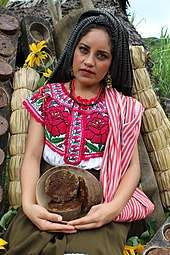
The average annual population growth rate of Mexico City was the first in the country at 0.2%. The state with the lowest population growth rate over the same period was Michoacán (-0.1%), whereas the states with the highest population growth rates were Quintana Roo (4.7%) and Baja California Sur (3.4%),[9] both of which are two of the least populous states and the last to be admitted to the Union in the 1970s. The average annual net migration rate of Mexico City over the same period was negative and the lowest of all political divisions of Mexico, whereas the states with the highest net migration rate were Quintana Roo (2.7), Baja California (1.8) and Baja California Sur (1.6).[10] While the national annual growth rate was still positive (1.0%) in the early years of the 2000s, the national net migration rate was negative (-4.75/1000 inhabitants), given the former strong flow of immigrants to the United States; an estimated 5.3 million undocumented Mexican immigrants lived in the United States in 2004[11] and 18.2 million American citizens in the 2000 Census declared having Mexican ancestry.[12] However, as of recent years in the 2010s, the net migration rate reached 0, given the strong economy of Mexico, changes in US Immigration Policy & Enforcement, US Legislative and CFR-8 decisions, plus the (then) slowly recovering US economy, causing many of its former residents to return. The Mexican government projects[13] that the Mexican population will grow to about 123 million by 2042 and then start declining slowly. Assumptions underlying this projection include fertility stabilizing at 1.85 children per woman and continued high net emigration (slowly decreasing from 583,000 in 2005 to 393,000 in 2050).
The states and Mexico City that make up the Mexican federation are collectively called "federal entities". The five most populous federal entities in 2005 were the State of Mexico (14.4 million), Mexico City (8.7 million), Veracruz (7.1 million), Jalisco (6.7 million) and Puebla (5.4 million), which collectively contain 40.7% of the national population. Mexico City, being coextensive with the Mexico City, is the most populous city in the country, while Greater Mexico City, that includes the adjacent municipalities that comprise a metropolitan area, is estimated to be the second most populous in the world (after Tokyo), according to the UN Urbanization Report.
Intense population growth in the northern states, especially along the US-Mexican border, changed the country's demographic profile in the second half of the 20th century, as the 1967 US-Mexico maquiladora agreement through which all products manufactured in the border cities could be imported duty-free to the US. Since the adoption of NAFTA in 1994, however, which allows all products to be imported duty-free regardless of their place of origin within Mexico, the non-border maquiladora share of exports has increased while that of border cities has decreased,.[14] This has led to decentralization and rapid economic growth in Mexican states (and cities), such as Quintana Roo (Cancun), Baja California Sur (La Paz), Nuevo Leon (Monterrey), Querétaro, and Aguascalientes. The population of each of these five states grew by more than one-third from 2000-2015, while the whole of Mexico grew by 22.6% in this period.
UN estimates
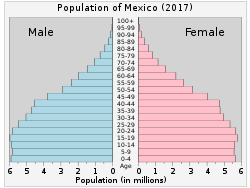
According to the 2012 revision of the World Population Prospects, the total population was 117,886,000 in 2010, compared to only 28,296,000 in 1950. The proportion of children below the age of 15 in 2010 was 30%, 64% of the population was between 15 and 65 years of age, and 6% was 65 years or older.[15]
| Total population (x 1000) |
Proportion aged 0–14 (%) |
Proportion aged 15–64 (%) |
Proportion aged 65+ (%) | |
|---|---|---|---|---|
| 1950 | 28 296 | 42.5 | 54.1 | 3.5 |
| 1955 | 33 401 | 44.5 | 52.2 | 3.3 |
| 1960 | 38 677 | 45.9 | 50.8 | 3.4 |
| 1965 | 45 339 | 46.8 | 49.6 | 3.5 |
| 1970 | 52 988 | 46.6 | 49.7 | 3.7 |
| 1975 | 61 708 | 46.2 | 50.1 | 3.7 |
| 1980 | 70 353 | 44.7 | 51.5 | 3.8 |
| 1985 | 77 859 | 42.1 | 53.9 | 3.9 |
| 1990 | 86 077 | 38.5 | 57.2 | 4.3 |
| 1995 | 95 393 | 35.9 | 59.6 | 4.5 |
| 2000 | 103 874 | 34.1 | 61.0 | 4.9 |
| 2005 | 110 732 | 32.3 | 62.4 | 5.3 |
| 2010 | 117 886 | 30.0 | 64.0 | 6.0 |
| 2015 | 127 017 | 27.6 | 65.9 | 6.5 |
| 2020 | 134 837 | 25.6 | 66.9 | 7.6 |
Structure of the population
Structure of the population (12.06.2010) (Census):[16]
| Age group | Male | Female | Total | Percent |
|---|---|---|---|---|
| 0-14 | 16 498 731 | 16 017 065 | 32 515 796 | 28,94 |
| 15-64 | 34 453 410 | 37 031 013 | 71 484 423 | 63,63 |
| 65+ | 3 202 871 | 3 736 049 | 6 938 913 | 6,18 |
| Male | Female | Total | % | |
|---|---|---|---|---|
| Total | 54 855 231 | 57 481 307 | 112 336 538 | 100 |
| 0-4 | 5 346 943 | 5 181 379 | 10 528 322 | 9.37 |
| 5-9 | 5 604 175 | 5 443 362 | 11 047 537 | 9.83 |
| 10-14 | 5 547 613 | 5 392 324 | 10 939 937 | 9.78 |
| 15-19 | 5 520 121 | 5 505 991 | 11 026 112 | 9.82 |
| 20-24 | 4 813 204 | 5 079 067 | 9 892 271 | 8.81 |
| 25-29 | 4 205 975 | 4 582 202 | 8 788 177 | 7.82 |
| 30-34 | 4 026 031 | 4 444 767 | 8 470 798 | 7.54 |
| 35-39 | 3 964 738 | 4 328 249 | 8 292 987 | 7.38 |
| 40-44 | 3 350 322 | 3 658 904 | 7 009 226 | 6.24 |
| 45-49 | 2 824 364 | 3 104 366 | 5 928 730 | 5.28 |
| 50-54 | 2 402 451 | 2 661 840 | 5 064 291 | 4.51 |
| 55-59 | 1 869 537 | 2 025 828 | 3 895 365 | 3.47 |
| 60-64 | 1 476 667 | 1 639 799 | 3 116 466 | 2.77 |
| 65-69 | 1 095 273 | 1 221 992 | 2 317 265 | 2.06 |
| 70-74 | 873 893 | 1 000 041 | 1 873 934 | 1.67 |
| 75-79 | 579 689 | 665 794 | 1 245 483 | 1.11 |
| 80-84 | 355 277 | 443 659 | 798 936 | 0.71 |
| 85-89 | 197 461 | 256 703 | 454 164 | 0.40 |
| 90-94 | 68 130 | 96 794 | 164 924 | 0.15 |
| 95-99 | 25 920 | 39 812 | 65 732 | 0.06 |
| 100+ | 7 228 | 11 247 | 18 475 | 0.02 |
| unknown | 700 219 | 697 187 | 1 397 406 | 1.24 |
Vital statistics
Registered births and deaths
Source: Instituto Nacional de Estadística y Geografía (INEGI)[17][18]
| Average population[19] | Live births | Deaths | Natural change | Crude birth rate (per 1000) | Crude death rate (per 1000) | Natural change (per 1000) | TFR | |
|---|---|---|---|---|---|---|---|---|
| 1936 | 786,388 | |||||||
| 1937 | 820,469 | |||||||
| 1938 | 822,586 | 43.5 | ||||||
| 1939 | 857,951 | 44.6 | ||||||
| 1940 | 19,763,000 | 875,471 | 44.3 | |||||
| 1941 | 20,208,000 | 878,935 | 43.5 | |||||
| 1942 | 20,657,000 | 940,067 | 45.5 | |||||
| 1943 | 21,165,000 | 963,317 | 45.5 | |||||
| 1944 | 21,674,000 | 958,119 | 44.2 | |||||
| 1945 | 22,233,000 | 999,093 | 44.9 | |||||
| 1946 | 22,779,000 | 994,838 | 442,935 | 551,903 | 43.7 | 19.4 | 24.3 | |
| 1947 | 23,440,000 | 1,079,816 | 390,087 | 689,729 | 46.1 | 16.6 | 29.5 | |
| 1948 | 24,129,000 | 1,090,867 | 407,708 | 683,159 | 44.7 | 16.9 | 27.8 | |
| 1949 | 24,833,000 | 1,109,446 | 438,970 | 670,476 | 46.0 | 17.7 | 28.3 | |
| 1950 | 28,296,000 | 1,174,947 | 418,430 | 756,517 | 41.5 | 14.8 | 26.7 | |
| 1951 | 29,110,000 | 1,183,788 | 458,238 | 725,550 | 40.7 | 15.7 | 24.9 | |
| 1952 | 29,980,000 | 1,195,209 | 408,823 | 786,386 | 39.9 | 13.6 | 26.2 | |
| 1953 | 30,904,000 | 1,261,775 | 446,127 | 815,648 | 40.8 | 14.4 | 26.4 | |
| 1954 | 31,880,000 | 1,339,837 | 378,752 | 961,085 | 42.0 | 11.9 | 30.1 | |
| 1955 | 32,906,000 | 1,377,917 | 407,522 | 970,395 | 41.9 | 12.4 | 29.5 | |
| 1956 | 33,978,000 | 1,427,722 | 368,740 | 1,058,982 | 42.0 | 10.9 | 31.2 | |
| 1957 | 35,095,000 | 1,485,202 | 414,545 | 1,070,657 | 42.3 | 11.8 | 30.5 | |
| 1958 | 36,253,000 | 1,447,578 | 404,529 | 1,043,049 | 39.9 | 11.2 | 28.8 | |
| 1959 | 37,448,000 | 1,589,606 | 396,924 | 1,192,682 | 42.4 | 10.6 | 31.8 | |
| 1960 | 38,677,000 | 1,608,174 | 402,545 | 1,205,629 | 41.6 | 10.4 | 31.2 | |
| 1961 | 39,939,000 | 1,647,006 | 388,857 | 1,258,149 | 41.2 | 9.7 | 31.5 | |
| 1962 | 41,234,000 | 1,705,481 | 403,046 | 1,302,435 | 41.4 | 9.8 | 31.6 | |
| 1963 | 42,564,000 | 1,756,624 | 412,834 | 1,343,790 | 41.3 | 9.7 | 31.6 | |
| 1964 | 43,931,000 | 1,849,408 | 408,275 | 1,441,133 | 42.1 | 9.3 | 32.8 | |
| 1965 | 45,339,000 | 1,888,171 | 404,163 | 1,484,008 | 41.6 | 8.9 | 32.7 | |
| 1966 | 46,784,000 | 1,954,340 | 424,141 | 1,530,199 | 41.8 | 9.1 | 32.7 | |
| 1967 | 48 264 000 | 1,981,363 | 420,298 | 1,561,065 | 41.1 | 8.7 | 32.3 | |
| 1968 | 49,788,000 | 2,058,251 | 452,910 | 1,605,341 | 41.3 | 9.1 | 32.2 | |
| 1969 | 51,361,000 | 2,037,561 | 458,886 | 1,578,675 | 39.7 | 8.9 | 30.7 | |
| 1970 | 52,988,000 | 2,132,630 | 485,656 | 1,646,974 | 40.2 | 9.2 | 31.1 | |
| 1971 | 54,669,000 | 2,231,399 | 458,323 | 1,773,076 | 40.8 | 8.4 | 32.4 | |
| 1972 | 56,396,000 | 2,346,002 | 476,206 | 1,869,796 | 41.6 | 8.4 | 33.2 | |
| 1973 | 58,156,000 | 2,572,287 | 458,915 | 2,113,372 | 44.2 | 7.9 | 36.3 | |
| 1974 | 59,931,000 | 2,522,580 | 433,104 | 2,089,476 | 42.1 | 7.2 | 34.9 | |
| 1975 | 61,708,000 | 2,254,497 | 435,888 | 1,818,609 | 36.5 | 7.1 | 29.5 | |
| 1976 | 63,486,000 | 2,366,305 | 455,660 | 1,910,645 | 37.3 | 7.2 | 30.1 | 5.7 |
| 1977 | 65,261,000 | 2,379,327 | 450,454 | 1,928,873 | 36.5 | 6.9 | 29.6 | |
| 1978 | 67,013,000 | 2,346,862 | 418,381 | 1,928,481 | 35.0 | 6.2 | 28.8 | |
| 1979 | 68,715,000 | 2,274,267 | 428,217 | 1,846,050 | 33.1 | 6.2 | 26.9 | |
| 1980 | 70,353,000 | 2,446,238 | 434,465 | 2,011,773 | 34.8 | 6.2 | 28.6 | |
| 1981 | 71,916,000 | 2,530,662 | 424,274 | 2,106,388 | 35.2 | 5.9 | 29.3 | 4.4 |
| 1982 | 73,416,000 | 2,392,849 | 412,345 | 1,980,504 | 32.6 | 5.6 | 27.0 | |
| 1983 | 74,880,000 | 2,609,088 | 413,403 | 2,195,685 | 34.8 | 5.5 | 29.3 | |
| 1984 | 76,351,000 | 2,511,894 | 410,550 | 2,101,344 | 32.9 | 5.4 | 27.5 | |
| 1985 | 77,859,000 | 2,655,671 | 414,003 | 2,241,668 | 34.1 | 5.3 | 28.8 | |
| 1986 | 79,410,000 | 2,577,045 | 400,079 | 2,176,966 | 32.5 | 5.0 | 27.4 | |
| 1987 | 80,999,000 | 2,794,390 | 400,280 | 2,394,110 | 34.5 | 4.9 | 29.6 | 3.8 |
| 1988 | 82,635,000 | 2,622,031 | 412,987 | 2,209,044 | 31.7 | 5.0 | 26.7 | |
| 1989 | 84,327,000 | 2,620,262 | 423,304 | 2,196,958 | 31.1 | 5.0 | 26.1 | |
| 1990 | 86,077,000 | 2,735,312 | 422,803 | 2,312,509 | 31.8 | 4.9 | 26.9 | 3.38 |
| 1991 | 87,890,000 | 2,756,447 | 411,131 | 2,345,316 | 31.4 | 4.7 | 26.7 | 3.28 |
| 1992 | 89,758,000 | 2,797,397 | 409,814 | 2,387,583 | 31.2 | 4.6 | 26.6 | 3.20 |
| 1993 | 91,654,000 | 2,839,686 | 416,335 | 2,423,351 | 31.0 | 4.5 | 26.4 | 3.12 |
| 1994 | 93,542,000 | 2,904,389 | 419,074 | 2,485,315 | 31.0 | 4.5 | 26.6 | 3.04 |
| 1995 | 95,393,000 | 2,750,444 | 430,278 | 2,320,166 | 28.8 | 4.5 | 24.3 | 2.97 |
| 1996 | 97,202,000 | 2,707,718 | 436,321 | 2,271,397 | 27.9 | 4.5 | 23.4 | 2.90 |
| 1997 | 98,969,000 | 2,698,425 | 440,437 | 2,257,988 | 27.3 | 4.5 | 22.8 | 2.83 |
| 1998 | 100,679,000 | 2,668,429 | 444,665 | 2,223,764 | 26.5 | 4.4 | 22.1 | 2.77 |
| 1999 | 102,317,000 | 2,769,089 | 443,950 | 2,325,139 | 27.1 | 4.3 | 22.7 | 2.71 |
| 2000 | 103,874,000 | 2,798,339 | 437,667 | 2,360,672 | 26.9 | 4.2 | 22.7 | 2.66 |
| 2001 | 105,340,000 | 2,767,610 | 443,127 | 2,324,483 | 26.3 | 4.2 | 22.1 | 2.61 |
| 2002 | 106,724,000 | 2,699,084 | 459,687 | 2,239,397 | 25.3 | 4.3 | 21.0 | 2.56 |
| 2003 | 108,056,000 | 2,655,894 | 472,140 | 2,183,754 | 24.6 | 4.4 | 20.2 | 2.52 |
| 2004 | 109,382,000 | 2,625,056 | 473,417 | 2,151,639 | 24.0 | 4.3 | 19.7 | 2.48 |
| 2005 | 110,732,000 | 2,567,906 | 495,240 | 2,072,666 | 23.2 | 4.5 | 18.7 | 2.45 |
| 2006 | 112,117,000 | 2,505,939 | 494,471 | 2,011,468 | 22.4 | 4.4 | 17.9 | 2.41 |
| 2007 | 113 530 000 | 2,655,083 | 514,420 | 2,140,663 | 23.4 | 4.5 | 18.9 | 2.38 |
| 2008 | 114,968,000 | 2,636,110 | 539,530 | 2,096,580 | 22.9 | 4.7 | 18.2 | 2.35 |
| 2009 | 116,423,000 | 2,577,214 | 564,673 | 2,012,541 | 22.1 | 4.9 | 17.3 | 2.31 |
| 2010 | 114,255,000 | 2,643,908 | 592,018 | 2,051,890 | 23.1 | 5.2 | 17.9 | 2.28 |
| 2011 | 115,683,000 | 2,586,287 | 590,693 | 1,995,594 | 22.3 | 5.1 | 17.2 | 2.25 |
| 2012 | 117,054,000 | 2,498,880 | 602,354 | 1,896,526 | 21.3 | 5.1 | 16.2 | 2.27 |
| 2013 | 118,395,000 | 2,478,889 | 623,599 | 1,855,290 | 20.9 | 5.3 | 15.6 | 2.24 |
| 2014 | 119,713,000 | 2,463,420 | 633,641 | 1,829,779 | 20.5 | 5.3 | 15.2 | 2.22 |
| 2015 | 121,005,000 | 2,353,596 | 655,694 | 1,697,902 | 19.4 | 5.4 | 14.0 | 2.13 |
| 2016 | 122,298,000 | 2,293,708 | 685,763 | 1,607,945 | 18.8 | 5.6 | 13.2 | 2.08 |
| 2017 | 123,415,000 | 2,234,039 | 703,047 | 1,530,992 | 18.1 | 5.8 | 12.3 | 1.97 |
| 2018 | 124,738,000 | 2,162,535 | 722,611 | 1,439,924 | 17.3 | 5.8 | 11.5 |
Estimates
.svg.png)
The following estimates were prepared by the Instituto Nacional de Estadística y Geografía:
| Crude birth rate (per 1000)[20] | Crude death rate (per 1000)[21] | Natural change (per 1000) | Total fertility rate[22] | |
|---|---|---|---|---|
| 1976 | 5.7 | |||
| 1981 | 4.4 | |||
| 1987 | 3.8 | |||
| 1990 | 27.9 | 5.6 | 22.3 | 3.4 |
| 1991 | 27.5 | 5.5 | 22.0 | 3.3 |
| 1992 | 27.1 | 5.4 | 21.7 | 3.2 |
| 1993 | 26.8 | 5.3 | 21.5 | 3.1 |
| 1994 | 26.3 | 5.2 | 21.1 | 3.0 |
| 1995 | 25.9 | 5.2 | 20.7 | 3.0 |
| 1996 | 25.4 | 5.1 | 20.3 | 2.9 |
| 1997 | 24.8 | 5.1 | 19.7 | 2.8 |
| 1998 | 24.3 | 5.1 | 19.2 | 2.8 |
| 1999 | 23.9 | 5.1 | 18.8 | 2.7 |
| 2000 | 23.4 | 5.1 | 18.3 | 2.6 |
| 2001 | 23.0 | 5.1 | 17.9 | 2.6 |
| 2002 | 22.6 | 5.1 | 17.5 | 2.6 |
| 2003 | 22.2 | 5.2 | 17.0 | 2.5 |
| 2004 | 21.8 | 5.2 | 16.6 | 2.5 |
| 2005 | 21.5 | 5.2 | 16.3 | 2.5 |
| 2006 | 21.1 | 5.3 | 15.8 | 2.4 |
| 2007 | 20.8 | 5.3 | 15.5 | 2.4 |
| 2008 | 20.4 | 5.4 | 15.0 | 2.3 |
| 2009 | 20.1 | 5.5 | 14.6 | 2.3 |
| 2010 | 19.7 | 5.6 | 14.1 | 2.3 |
| 2011 | 19.4 | 5.6 | 13.8 | 2.3 |
| 2012 | 19.2 | 5.7 | 13.5 | 2.2 |
| 2013 | 19.0 | 5.7 | 13.3 | 2.2 |
| 2014 | 18.7 | 5.7 | 13.0 | 2.2 |
| 2015 | 18.5 | 5.7 | 12.8 | 2.2 |
| 2016 | 18.3 | 5.8 | 12.5 | 2.2 |
Life expectancy from 1893 to 1950
Life expectancy in Mexico from 1893 to 1950. Source: Our World In Data
| Years | 1893 | 1894 | 1895 | 1896 | 1897 | 1898 | 1899 | 1900 | 1901 | 1902 | 1903 | 1904 | 1905 | 1906 | 1907 | 1908 | 1909 | 1910[23] |
|---|---|---|---|---|---|---|---|---|---|---|---|---|---|---|---|---|---|---|
| Life expectancy in Mexico | 23.3 | 26.6 | 29.5 | 28.8 | 26.2 | 27.0 | 25.0 | 25.0 | 26.7 | 28.4 | 28.7 | 29.1 | 26.8 | 27.8 | 28.0 | 28.7 | 29.2 | 28.0 |
| Years | 1920 | 1922 | 1923 | 1924 | 1925 | 1926 | 1927 | 1928 | 1929 | 1930[23] |
|---|---|---|---|---|---|---|---|---|---|---|
| Life expectancy in Mexico | 34.0 | 32.6 | 33.5 | 32.8 | 32.1 | 34.2 | 40.3 | 34.5 | 35.4 | 34.0 |
| Years | 1931 | 1932 | 1933 | 1934 | 1935 | 1936 | 1937 | 1938 | 1939 | 1940[23] |
|---|---|---|---|---|---|---|---|---|---|---|
| Life expectancy in Mexico | 37.7 | 38.4 | 37.3 | 38.2 | 40.4 | 38.3 | 36.8 | 39.4 | 45.5 | 39.0 |
| Years | 1941 | 1942 | 1943 | 1944 | 1945 | 1946 | 1947 | 1948 | 1949 | 1950[23] |
|---|---|---|---|---|---|---|---|---|---|---|
| Life expectancy in Mexico | 42.6 | 39.8 | 42.8 | 43.2 | 44.2 | 44.8 | 46.3 | 48.3 | 45.8 | 50.7 |
UN estimates
The Population Department of the United Nations prepared the following estimates. [15]
| Period | Live births per year |
Deaths per year |
Natural change per year |
CBR* | CDR* | NC* | TFR* | IMR* | Life expectancy total |
Life expectancy males |
Life expectancy females |
|---|---|---|---|---|---|---|---|---|---|---|---|
| 1950–1955 | 1 469 000 | 509 000 | 959 000 | 48.3 | 16.7 | 31.6 | 6.75 | 121 | 50.7 | 48.9 | 52.5 |
| 1955–1960 | 1 675 000 | 483 000 | 1 193 000 | 46.6 | 13.5 | 33.1 | 6.78 | 102 | 55.3 | 53.3 | 57.3 |
| 1960–1965 | 1 878 000 | 481 000 | 1 397 000 | 44.6 | 11.5 | 33.1 | 6.75 | 88 | 58.5 | 56.4 | 60.6 |
| 1965–1970 | 2 147 000 | 510 000 | 1 637 000 | 43.6 | 10.4 | 33.2 | 6.75 | 80 | 60.3 | 58.2 | 62.5 |
| 1970–1975 | 2 434 000 | 521 000 | 1 913 000 | 43.7 | 9.2 | 34.5 | 6.71 | 69 | 62.6 | 60.1 | 65.2 |
| 1975–1980 | 2 406 000 | 490 000 | 1 916 000 | 37.2 | 7.5 | 29.7 | 5.40 | 57 | 65.3 | 62.2 | 68.6 |
| 1980–1985 | 2 352 000 | 470 000 | 1 882 000 | 32.3 | 6.3 | 26.0 | 4.37 | 47 | 67.7 | 64.4 | 71.2 |
| 1985–1990 | 2 385 000 | 466 000 | 1 919 000 | 29.7 | 5.7 | 24.0 | 3.75 | 40 | 69.8 | 66.8 | 73.0 |
| 1990–1995 | 2 493 000 | 470 000 | 2 022 000 | 27.4 | 5.2 | 22.3 | 3.23 | 33 | 71.8 | 69.0 | 74.6 |
| 1995–2000 | 2 535 000 | 471 000 | 2 064 000 | 25.2 | 4.8 | 20.5 | 2.85 | 28 | 73.7 | 71.3 | 76.1 |
| 2000–2005 | 2 449 000 | 492 000 | 1 958 000 | 23.0 | 4.6 | 18.4 | 2.61 | 21 | 75.0 | 72.4 | 77.4 |
| 2005–2010 | 2 355 000 | 513 000 | 1 841 000 | 20.7 | 4.6 | 16.1 | 2.40 | 17 | 76.3 | 73.7 | 78.6 |
| 2010–2015 | 2 353 000 | 579 000 | 1 774 000 | 19.4 | 4.8 | 14.6 | 2.29 | ||||
| 2015–2020 | 2 291 000 | 635 000 | 1 656 000 | 17.6 | 4.9 | 12.7 | 2.14 | ||||
| 2020–2025 | 2 206 000 | 699 000 | 1 507 000 | 16.0 | 5.1 | 11.0 | 2.00 | ||||
| 2025–2030 | 2 105 000 | 773 000 | 1 332 000 | 14.6 | 5.4 | 9.2 | 1.89 | ||||
| 2030–2035 | 2 014 000 | 860 000 | 1 154 000 | 13.4 | 5.7 | 7.7 | 1.81 | ||||
| 2035–2040 | 1 936 000 | 960 000 | 976 000 | 12.5 | 6.2 | 6.3 | 1.76 | ||||
| * CBR = crude birth rate (per 1000); CDR = crude death rate (per 1000); NC = natural change (per 1000); IMR = infant mortality rate per 1000 births; TFR = total fertility rate (number of children per woman) | |||||||||||
International migration
Immigration to Mexico

Aside from the original Spanish colonists, many Europeans immigrated to Mexico in the late 19th and early 20th centuries. Non-Spanish immigrant groups included British, Irish, Italian, German, French and Dutch.[24] Large numbers of Middle Eastern immigrants arrived in Mexico during the same period, mostly from Syria and Lebanon.[25] Asian immigrants, mostly Chinese, some via the United States, settled in northern Mexico, whereas Koreans settled in central Mexico.[26]

During the 1970s and 1980s Mexico opened its doors to immigrants from Latin America, mainly political refugees from Chile, Cuba, Peru, Colombia and Central America. The PRI governments, in power for most of the 20th century, had a policy of granting asylum to fellow Latin Americans fleeing political persecution in their home countries. A second wave of immigrants has come to Mexico as a result of the economic crises experienced by some countries in the region. The Argentine community is quite significant estimated to be somewhere between 11,000 and 30,000.[27][28]
Due to the 2008 Financial Crisis and the resulting economic decline and high unemployment in Spain, many Spaniards have been emigrating to Mexico to seek new opportunities.[29] For example, during the last quarter of 2012, a number of 7,630 work permits were granted to Spaniards.[30]
Mexico is also the country where the largest number of American citizens live abroad, with Mexico City playing host to the largest number of American citizens abroad in the world. The American Citizens Abroad Association estimated in 1999 that a little more than one million Americans live in Mexico (which represent 1% of the population in Mexico and 25% of all American citizens living abroad).[31] This immigration phenomenon could well be explained by the interaction of both countries under the North American Free Trade Agreement (NAFTA), but also by the fact that Mexico has become a popular destination for retirees, especially the small towns: just in the State of Guanajuato, in San Miguel de Allende and its surroundings, 10,000 Americans have their residence.[32]
Discrepancies between the figures of official legal aliens and all foreign-born residents is quite large. The official figure for foreign-born residents in Mexico in 2000 was 493,000,[33] with a majority (86.9%) of these born in the United States (except Chiapas, where the majority of immigrants are from Central America). The six states with the most immigrants are Baja California (12.1% of total immigrants), Mexico City (11.4%), Jalisco (9.9%), Chihuahua (9%) and Tamaulipas (7.3%).[33]
Emigration from Mexico
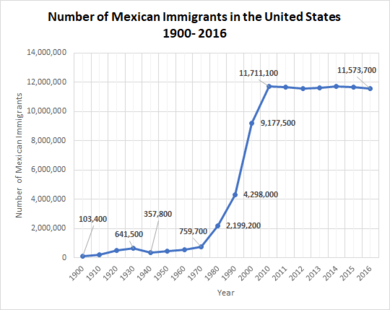
The national net migration rate of Mexico is negative, estimated at -1.8 migrants per 1,000 population as of 2017.[35] The great majority of Mexican emigrants have moved to the United States of America. This migration phenomenon is not new, but it has been a defining feature in the relationship of both countries for most of the twentieth century.[36] During World Wars I and II, the United States government approved the recruitment of Mexican workers in their territory, and tolerated unauthorized migration in order to obtain additional farm- and industrial-workers to fill the necessary spots vacated by the population in war, and to supply the increase in the demand for labor. Nonetheless, the United States unilaterally ended the wartime programs - in part as a result of arguments from labor and from civil-rights groups.[37]

In spite of that, emigration of Mexicans continued throughout the rest of the 20th century at varying rates. It grew significantly during the 1990s and continued to do so in the first years of the 2000s. In fact, it has been estimated that 37% of all Mexican immigrants to the United States in the 20th century arrived during the 1990s.[36] In 2000 approximately 20 million American residents identified themselves as either Mexican, Mexican-Americans or of Mexican origin, making "Mexican" the sixth-most cited ancestry of all US residents.[38]
In 2000 the INEGI estimated that about eight million Mexican-born people, which then was equivalent to 8.7% of the population of Mexico itself, lived in the United States of America.[39] In that year, the Mexican states sending the greatest numbers of emigrants to the United States were Jalisco (170,793), Michoacán (165,502), and Guanajuato (163,338); the total number of Mexican emigrants to the United States in 2000, both legal and illegal, was estimated at 1,569,157; the great majority of these were men.[40] Approximately 30% of emigrants come from rural communities.[41] In 2000, 260,650 emigrants returned to Mexico.[42] According to the Pew Hispanic Center in 2006, an estimated ten percent of all Mexican citizens lived in the United States.[43] The population of Mexican immigrants residing illegally in the United States fell from around seven million in 2007 to about 6.1 million in 2011.[44] This trajectory has been linked to the economic downturn which started in 2008 and which reduced available jobs, and to the introduction of stricter immigration laws in many States.[45][46][47][48] According to the Pew Hispanic Center the total number of Mexican-born people had stagnated in 2010 and then began to fall.[49]
After the Mexican-American community, Mexican Canadians are the second-largest group of emigrant Mexicans, with a population of over 50,000. A significant but unknown number of mestizos of Mexican descent migrated to the Philippines during the era of the Viceroyalty of New Spain, when the Philippines was a territory under the rule of Mexico city.[50] Mexicans live throughout Latin America as well as in Australia, France, Germany, Italy, Japan, and the United Arab Emirates.
| Emigration list from Mexico[51] Mexican residents in the world by countries | |||
|---|---|---|---|
| Country | Population | Position | Continent |
| 36,300,000[52] | 1 | North America | |
| 36,225[53] | 2 | North America | |
| 15,399[54] | 3 | Europe | |
| 14,481[55] | 4 | Central America | |
| 13,377[56] | 5 | South America | |
| 8,848[57] | 6 | Europe | |
| 6,750[58] | 7 | South America | |
| 5,125[59] | 8 | Europe | |
| 4,872[60] | 9 | Oceania | |
| 4,601[61] | 10 | Europe | |
| 4,252[62] | 11 | Asia | |
| 3,758[63] | 12 | Europe | |
| 3,485[63] | 13 | Europe | |
| 3,075[64] | 14 | South America | |
| 2,794[65] | 15 | Europe | |
| 2,349[66] | 16 | Central America | |
| 2,327[67] | 17 | Central America | |
| 2,299[68] | 18 | Central America | |
| 2,286[69] | 19 | South America | |
| 1,874[70] | 20 | South America | |
| 1,778[71] | 21 | South America | |
| The list includes also temporary residents (1–3 years' stay) | |||
Cities and metropolitan areas
Settlements, cities and municipalities
| Most populated municipalities | |
|---|---|
| Municipality of Guadalajara | |
| Municipality | Pop. (2005) |
| Ecatepec de Morelos | 1,688,258 |
| Guadalajara | 1,600,940 |
| Puebla | 1,485,941 |
| Tijuana | 1,410,700 |
| León | 1.325.210 |
| Juárez | 1,313,338 |
In 2005 Mexico had 187,938 localidades (lit. "localities" or "settlements"), which are census-designated places, which could be defined as a small town, a large city, or simply as a single unit housing in a rural area whether situated remotely or close to an urban area. A city is defined to be a settlement with more than 2,500 inhabitants. In 2005 there were 2,640 cities with a population between 2,500 and 15,000 inhabitants, 427 with a population between 15,000 and 100,000 inhabitants, 112 with a population between 100,000 and one million, and 11 with a population of more than one million.[72] All cities are considered "urban areas" and represent 76.5% of total population. Settlements with less than 2,500 inhabitants are considered "rural communities" (in fact, more than 80,000 of those settlements have only one or two housing units). Rural population in Mexico is 22.2% of total population.[72]
Municipalities (municipios in Spanish) and boroughs (delegaciones in Spanish) are incorporated places in Mexico, that is, second or third-level political divisions with internal autonomy, legally prescribed limits, powers and functions. In terms of second-level political divisions there are 2,438 municipalities and Mexico and 16 semi-autonomous boroughs (all within the Federal District). A municipality can be constituted by one or more cities one of which is the cabecera municipal (municipal seat). Cities are usually contained within the limits of a single municipality, with a few exceptions in which small areas of one city may extend to other adjacent municipalities without incorporating the city which serves as the municipal seat of the adjacent municipality. Some municipalities or cities within municipalities are further divided into delegaciones or boroughs. However, unlike the boroughs of the Federal District, these are third-level administrative divisions; they have very limited autonomy and no elective representatives.
Municipalities in central Mexico are usually very small in area and thus coextensive with cities (as is the case of Guadalajara, Puebla and León), whereas municipalities in northern and southeastern Mexico are much larger and usually contain more than one city or town that may not necessarily conform a single urban agglomeration (as is the case of Tijuana).
Metropolitan areas
A metropolitan area in Mexico is defined to be the group of municipalities that heavily interact with each other, usually around a core city.[73] In 2004, a joint effort between CONAPO, INEGI and the Ministry of Social Development (SEDESOL) agreed to define metropolitan areas as either:[73]
- the group of two or more municipalities in which a city with a population of at least 50,000 is located whose urban area extends over the limit of the municipality that originally contained the core city incorporating either physically or under its area of direct influence other adjacent predominantly urban municipalities all of which have a high degree of social and economic integration or are relevant for urban politics and administration; or
- a single municipality in which a city of a population of at least one million is located and fully contained, (that is, it does not transcend the limits of a single municipality); or
- a city with a population of at least 250,000 which forms a conurbation with other cities in the United States of America.
In 2004 there were 55 metropolitan areas in Mexico, in which close to 53% of the country's population lives. The most populous metropolitan area in Mexico is the Metropolitan Area of the Valley of Mexico, or Greater Mexico City, which in 2005 had a population of 19.23 million, or 19% of the nation's population. The next four largest metropolitan areas in Mexico are Greater Guadalajara (4.1 million), Greater Monterrey (3.7 million), Greater Puebla (2.1 million) and Greater Toluca (1.6 million),[74] whose added population, along with Greater Mexico City, is equivalent to 30% of the nation's population. Greater Mexico City was the fastest growing metropolitan area in the country since the 1930s until the late 1980s. Since then, the country has slowly become economically and demographically less centralized. From 2000 to 2005 the average annual growth rate of Greater Mexico City was the lowest of the five largest metropolitan areas, whereas the fastest growing metropolitan area was Puebla (2.0%) followed by Monterrey (1.9%), Toluca (1.8%) and Guadalajara (1.8%).[74]
.jpg) Mexico City 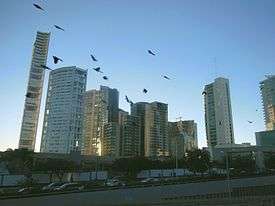 Guadalajara  Monterrey |
Rank | Metropolitan area | Largest city | State | Metro area population | 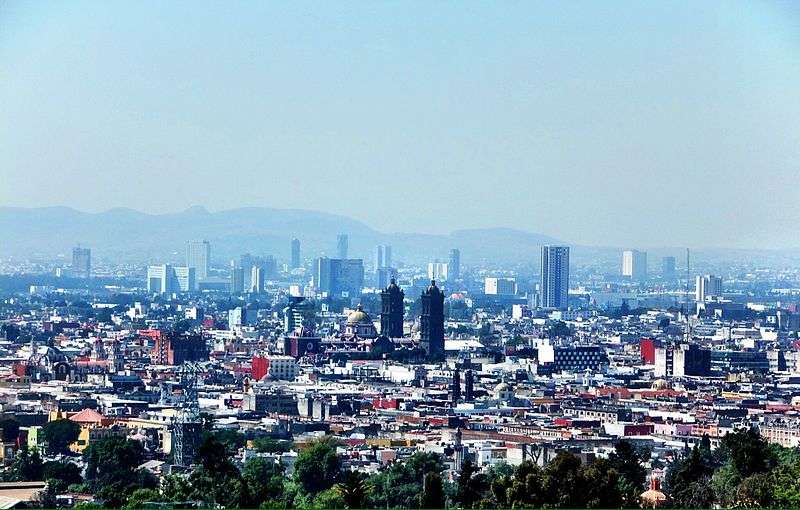 Puebla 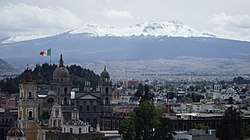 Toluca  Tijuana | |||||||||
|---|---|---|---|---|---|---|---|---|---|---|---|---|---|---|---|
| 1 | Greater Mexico City | Mexico City | 20,892,724 | ||||||||||||
| 2 | Guadalajara metropolitan area | Guadalajara | 4,887,383 | ||||||||||||
| 3 | Monterrey metropolitan area | Monterrey | 4,689,601 | ||||||||||||
| 4 | Puebla metropolitan area | Puebla | 2,941,988 | ||||||||||||
| 5 | Greater Toluca | Toluca | 2,202,886 | ||||||||||||
| 6 | Tijuana | Tijuana | 1,840,710 | ||||||||||||
| 7 | León metropolitan area | León | 1,768,193 | ||||||||||||
| 8 | Ciudad Juárez | Ciudad Juárez | 1,391,180 | ||||||||||||
| 9 | La Laguna metropolitan area | Torreón | 1,342,195 | ||||||||||||
| 10 | Querétaro | Querétaro | 1,323,640 | ||||||||||||
| 11 | Greater San Luis Potosí | San Luis Potosí | 1,159,807 | ||||||||||||
| 12 | Mérida | Mérida | 1,143,041 | ||||||||||||
| Source: INEGI[75] | |||||||||||||||
Other demographics statistics


Demographic statistics according to the World Population Review.[79]

- One birth every 14 seconds
- One death every 41 seconds
- One net migrant every 9 minutes
- Net gain of one person every 23 seconds
Demographic statistics according to the CIA World Factbook, unless otherwise indicated.[80]
- Population
- 125,959,205 (July 2018 est.)
Demographic statistics according to Mexico's National Institute of Statistics.[81]
Ethnic groups in mexico
21% indigenous mexicans (native american).
25% mestizo (indigenous+european).
47% light skinned-mexican or white-mexicans ("castizo"mostly european or "white"european descendent).
1% asian-mexicans (mostly asian or asian descendent).
5% afro-mexicans (mostly black or black descendent).
1% not classified.
- hair color
18% blond hair.
2% red hair.
80% black hair or dark brown.
- eye color
28% light-colored eyes.
72% dark- or mixed eyes.
- Age structure
- 0-14 years: 26.61% (male 17,143,124 /female 16,378,309)
- 15-24 years: 17.35% (male 11,072,817 /female 10,779,029)
- 25-54 years: 40.91% (male 24,916,204 /female 26,612,272)
- 55-64 years: 7.87% (male 4,538,167 /female 5,375,867)
- 65 years and over: 7.26% (male 4,079,513 /female 5,063,903) (2018 est.)
- Median age
- total: 28.6 years Country comparison to the world: 135th
- male: 27.5 years
- female: 29.7 years (2018 est.)
- Birth rate
- 18.1 births/1,000 population (2018 est.) Country comparison to the world: 93rd
- Death rate
- 5.4 deaths/1,000 population (2018 est.) Country comparison to the world: 180th
- Net migration rate
- -1.8 migrant(s)/1,000 population (2018 est.) Country comparison to the world: 158th
- Total fertility rate
- 2.22 children born/woman (2018 est.) Country comparison to the world: 94th
- Contraceptive prevalence rate
- 66.9% (2015)
- Population growth rate
- 1.09% (2018 est.) Country comparison to the world: 101st
- Mother's mean age at first birth
- 21.3 years (2008 est.)
- Languages
- Spanish only 92.7%, Spanish and indigenous languages 5.7%, indigenous only 0.8%, unspecified 0.8% (2005)
- note: indigenous languages include various Mayan, Nahuatl, and other regional languages
- Religions
- Roman Catholic 82.7%, Pentecostal 1.6%, Jehovah's Witness 1.4%, other Evangelical Churches 5%, other 1.9%, none 4.7%, unspecified 2.7% (2010 est.)
- Population distribution
- most of the population is found in the middle of the country between the states of Jalisco and Veracruz; approximately a quarter of the population lives in and around Mexico City
- Life expectancy at birth
- total population: 76.3 years
- male: 73.5 years
- female: 79.2 years (2018 est.)
- Dependency ratios
- total dependency ratio: 51.4 (2015 est.)
- youth dependency ratio: 41.6 (2015 est.)
- elderly dependency ratio: 9.8 (2015 est.)
- potential support ratio: 10.2 (2015 est.)
- Urbanization
- urban population: 80.2% of total population (2018)
- rate of urbanization: 1.59% annual rate of change (2015-20 est.)
- Obesity - adult prevalence rate
- 28.9% (2016) Country comparison to the world: 29th
- Children under the age of 5 years underweight
- 4.2% (2016) Country comparison to the world: 87th
- Education expenditures
- 5.2% of GDP (2015) Country comparison to the world: 59th
- Literacy
definition: age 15 and over can read and write (2016 est.)
- total population: 94.9%
- male: 95.8%
- female: 94% (2016 est.)
- School life expectancy (primary to tertiary education)
- total: 14 years
- male: 14 years
- female: 14 years (2016)
- Unemployment, youth ages 15–24
- total: 6.9%. Country comparison to the world: 157th
- male: 6.5%
- female: 7.6% (2018 est.)
- Sex ratio
- at birth: 1.05 male(s)/female
- 0-14 years: 1.05 male(s)/female
- 15-24 years: 1.03 male(s)/female
- 25-54 years: 0.94 male(s)/female
- 55-64 years: 0.84 male(s)/female
- 65 years and over: 0.81 male(s)/female
- total population: 0.96 male(s)/female (2018 est.)
Ethnic groups
Mexico is ethnically diverse. The second article of the Mexican Constitution defines the country to be a pluricultural state originally based on its indigenous peoples.
Mestizo
A large majority of Mexicans have been classified as "Mestizos", meaning in modern Mexican usage that they identify fully neither with any indigenous culture nor with a Spanish cultural heritage, but rather identify as having cultural traits incorporating elements from both indigenous and Spanish traditions. By the deliberate efforts of post-revolutionary governments the "Mestizo identity" was constructed as the base of the modern Mexican national identity, through a process of cultural synthesis referred to as mestizaje [mestiˈsahe]. Mexican politicians and reformers such as José Vasconcelos and Manuel Gamio were instrumental in building a Mexican national identity upon the concept of mestizaje.[82][83]

Since the Mestizo identity promoted by the government is more of a cultural identity than a biological one it has achieved a strong influence in the country, with a good number of phenotypically white people identifying with it, leading to being considered Mestizos in Mexico's demographic investigations and censuses due the ethnic criteria having its base on cultural traits rather than biological ones.[84] A similar situation occurs regarding the distinctions between Indigenous peoples and Mestizos: while the term Mestizo is sometimes used in English with the meaning of a person with mixed indigenous and European blood, In Mexican society a indigenous person can be considered mestizo.[85] and a person with none or a very low percentage of indigenous genetic heritage would be considered fully indigenous either by speaking an indigenous language or by identifying with a particular indigenous cultural heritage.[86][87][88] In the Yucatán peninsula the word Mestizo has a different meaning, with it being to refer to the Maya-speaking populations living in traditional communities, because during the caste war of the late 19th century those Maya who did not join the rebellion were classified as Mestizos.[89] In Chiapas the word "Ladino" is used instead of mestizo.[90]

Given that the word Mestizo has different meanings in Mexico, estimates of the Mexican Mestizo population vary widely. According to the Encyclopædia Britannica, which uses a biology-based approach, between one half and two thirds of the Mexican population is Mestizo.[91] A culture-based estimate gives the percentage of Mestizos as high as 90%.[92]

The use of variated methods and criteria to quantify the number of Mestizos in Mexico is not new: Since several decades ago, many authors have analyzed colonial censuses data and have made different conjectures respecting the ethnic composition of the population of colonial Mexico/New Spain. There are Historians such as Gonzalo Aguirre-Beltrán who claim that practically the totality of New Spain's population, in reality, were Mestizos, using to back up his claims arguments such as that affairs of Spaniards with non-Europeans due the alleged absence of female European immigrants were widespread as well as there being a huge desire of Mestizos to "pass" as Spaniards, this because Spanishness was seen as a symbol of high status.[93][94] Other historians however, point that Aguirre-Beltran numbers tend to have inconsistencies and take too much liberties (it is pointed out that on 1646, when according to historic registers the mestizo population was of 1% he estimates it to be 16.6% already, with this being attributed to him interpreting the data in a way convenient for a historic narrative),[95][96] often omitting data of New Spain's northern and western provinces.[97] His self-made classifications thus, although could be plausible, are not useful for precise statistical analysis.[98] According XXIst century historians, Aguirre Beltran also disregards facts such as the population dynamics of New Spain being different depending of the region at hand (i.e. miscegenation couldn't happen in a significative amount in regions on which the native population was openly hostile until early 20th century, such as most of New Spain's internal provinces, which nowadays are the northern and western regions of Mexico),[96] or that historic accounts made by investigators at the time consistently observed that New Spain's European population was notoriously concerned with preserving their European heritage, with practices such as inviting relatives and friends directly from Spain or favouring Europeans for marriage even if they were from a lower socioeconomic level than them being common.[99][95][96] Newer publications that do cite Aguirre-Beltran's work take those factors into consideration, stating that the Spaniard/Euromestizo/Criollo ethnic label was composed on its majority by descendants of Europeans albeit the category may have included people with some non-European ancestry.[100]
Indigenous peoples
.png)
Prior to contact with Europeans the indigenous peoples of Mexico had not had any kind of shared identity.[101] Indigenous identity was constructed by the dominant Euro-Mestizo majority and imposed upon the indigenous people as a negatively defined identity, characterized by the lack of assimilation into modern Mexico. Indigenous identity therefore became socially stigmatizing.[102] Cultural policies in early post-revolutionary Mexico were paternalistic towards the indigenous people, with efforts designed to help indigenous peoples achieve the same level of progress as the rest of society, eventually assimilating indigenous peoples completely to Mestizo Mexican culture, working toward the goal of eventually solving the "Indian problem" by transforming indigenous communities into mestizo communities.[103]
The category of "indigena" (indigenous) in Mexico has been defined based on different criteria through history, this means that the percentage of the Mexican population defined as "indigenous" varies according to the definition applied. It can be defined narrowly according to linguistic criteria including only persons that speak an Indigenous language, based on this criteria approximately 5.4% of the population is Indigenous.[104] Nonetheless, activists for the rights of indigenous peoples have referred to the usage of this criteria for census purposes as "statistical genocide"[105][106]
Other surveys made by the Mexican government do count as Indigenous all persons who speak an indigenous language and people who do not speak indigenous languages nor live in indigenous communities but self-identifies as Indigenous.
According to this criteria, the National Commission for the Development of Indigenous Peoples (Comisión Nacional para el Desarrollo de los Pueblos Indígenas, or CDI in Spanish) and the INEGI (Mexico's National Institute of Statistics and Geography), state that there are 15.7 million indigenous people in Mexico of many different ethnic groups,[107] which constitute 14.9% of the population in the country.[108]
Finally, according to the latest intercensal survey carried out by the Mexican government in 2015, Indigenous people make up 21.5% of Mexico's population. In this occasion, people who self-identified as "Indigenous" and people who self-identified as "partially Indigenous" were classified in the "Indigenous" category altogether.[109]
| Largest indigenous peoples | |
|---|---|
| Mayas in Chiapas | |
| Group | Number |
| Nahua peoples (Nawatlaka) | 2,445,969 |
| Maya (Maaya) | 1,475,575 |
| Zapotec (Binizaa) | 777,253 |
| Mixtec (Ñuu sávi) | 726,601 |
| Otomí (Hñähñü) | 646,875 |
| Totonac (Tachihuiin) | 411,266 |
| Source: CDI (2000) | |
.jpg)
The Mexican constitution not only recognizes the 62 indigenous peoples living in Mexican territory but also grants them autonomy and protects their culture and languages. This protection and autonomy is extended to those Amerindian ethnic groups which have migrated from the United States — like the Cherokees and Kickapoos — and Guatemala during the 19th and 20th centuries. Municipalities in which indigenous peoples are located can keep their normative traditional systems in relation to the election of their municipal authorities. This system is known as Usos y Costumbres, roughly translated as "customs and traditions".
According to official statistics —as reported by the National Commission for the Development of Indigenous Peoples or CDI— Amerindians make up 10-14%[110] of the country's population, more than half of them (5.4% of total population) speak an indigenous language and a tenth (1.2% of total population) do not speak Spanish.[111] Official statistics of the CDI[112] report that the states with the greatest percentage of people who speak an Amerindian language or identify as Amerindian are Yucatán (59%), Oaxaca (48%), Quintana Roo (39%), Chiapas (28%), Campeche (27%), Hidalgo (24%), Puebla (19%), Guerrero (17%), San Luis Potosí (15%) and Veracruz (15%). Oaxaca is the state with the greatest number of distinct indigenous peoples and languages in the country.
Mexicans of European descent

European Mexicans are Mexican citizens of full or majority European descent.[113] Europeans began arriving in Mexico during the Spanish conquest of the Aztec Empire and continued immigrating to the country during colonial and independent Mexico. According to 20th and 21st century academics, large scale intermixing between the European immigrants and the native Indigenous peoples would produce a Mestizo group which would become the overwhelming majority of Mexico's population by the time of the Mexican revolution. However, according to church registers from the colonial times, the majority (73%) of Spanish men married with Spanish women. Said registers also put in question other narratives held by contemporary academics, such as European immigrants who arrived to Mexico being almost exclusively men or that "pure Spanish" people were all part of a small powerful elite as Spaniards were often the most numerous ethnic group in the colonial cities[115][116](currently on discussion) as there were menial workers and people in poverty who were of complete Spanish origin.[117]

Estimates of Mexico's white population differ greatly in both, methodology and percentages given, extra-official sources such as The World Factbook and Encyclopedia Britannica, which use the 1921 census results as the base of their estimations calculate Mexico's White population as only 9%[118] or between one tenth to one fifth one tenth or one fifth[119] (the results of the 1921 census, however, have been contested by various historians and deemed inaccurate).[120] Surveys that account for phenotypical traits and have performed actual field research suggest rather higher percentages: using the presence of blond hair as reference to classify a Mexican as white, the Metropolitan Autonomous University of Mexico calculated the percentage of said ethnic group at 23%.[121] With a similar methodology, the American Sociological Association obtained a percentage of 18.8% having its higher frequency on the North region (22.3%–23.9%) followed by the Center region (18.4%–21.3%) and the South region (11.9%).[122]

Another study made by the University College London in collaboration with Mexico's National Institute of Anthropology and History found that the frequencies of blond hair and light eyes in Mexicans are of 18% and 28% respectively,[123] surveys that use as reference skin color such as those made by Mexico's National Council to Prevent Discrimination and Mexico's National Institute of Statistics and Geography reported a percentages of 47% in 2010[124][125][126] and 49% in 2017[127][128] respectively. A study performed in hospitals of Mexico City reported that an average 51.8% of Mexican newborns presented the congenital skin birthmark known as the Mongolian spot.[129] The Mongolian spot appears with a very high frequency (85-95%) in Asian, Native American, and African children.[130] The skin lesion reportedly almost always appears on South American[131] and Mexican children who are racially Mestizos,[132] while having a very low frequency (5–10%) in Caucasian children.[133] According to the Mexican Social Security Institute (shortened as IMSS) nationwide, around half of Mexican babies have the Mongolian spot.[134]

Mexico's northern and western regions have the highest percentages of European population, with the majority of the people not having native admixture or being of predominantly European ancestry, resembling in aspect that of northern Spaniards.[135] In the north and west of Mexico, the indigenous tribes were substantially smaller than those found in central and southern Mexico, and also much less organized, thus they remained isolated from the rest of the population or even in some cases were hostile towards Mexican colonists. The northeast region, in which the indigenous population was eliminated by early European settlers, became the region with the highest proportion of whites during the Spanish colonial period. However, recent immigrants from southern Mexico have been changing, to some degree, its demographic trends.[136]
While the majority of European immigration to Mexico has been Spanish with the first wave starting with the colonization of America and the last one being a consequence of the Spanish Civil War of 1937,[137] immigrants from other European countries have arrived to Mexico as well: during the Second Mexican Empire the immigration was mostly French, and during the late nineteenth and early twentieth centuries migrants mainly from Italy, the United Kingdom, Ireland and Germany followed.[24][138] Additionally small numbers of White Americans, Croats, Armenians, Greeks, Poles, Romanians, Russians and Ashkenazi Jews came.[138] The European Jewish immigrants joined the Sephardic community that lived in Mexico since colonial times, though many lived as Crypto-Jews, mostly in the northern states of Nuevo León and Tamaulipas.[139] Some communities of European immigrants have remained isolated from the rest of the general population since their arrival, among them the German-speaking Mennonites from Russia of Chihuahua and Durango,[140] and the Venetos of Chipilo, Puebla, which have retained their original languages.[141]
Gypsies came to Mexico from Spain during the colonial period.
Middle Eastern Mexicans
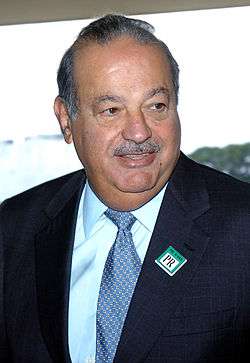
An Arab Mexican is a Mexican citizen of Arabic-speaking origin who can be of various ancestral origins. The vast majority of Mexico's 1.1 million Arabs are from either Lebanese, Syrian, Iraqi, or Palestinian background.[142]
The interethnic marriage in the Arab community, regardless of religious affiliation, is very high; most community members have only one parent who has Arab ethnicity. As a result of this, the Arab community in Mexico shows marked language shift away from Arabic. Only a few speak any Arabic, and such knowledge is often limited to a few basic words. Instead the majority, especially those of younger generations, speak Spanish as a first language. Today, the most common Arabic surnames in Mexico include Nader, Hayek, Ali, Haddad, Nasser, Malik, Abed, Mansoor, Harb and Elias.
Arab immigration to Mexico started in the 19th and early 20th centuries. Roughly 100,000 Arabic-speakers settled in Mexico during this time period. They came mostly from Lebanon, Syria, Palestine, and Iraq and settled in significant numbers in Nayarit, Puebla, Mexico City and the Northern part of the country (mainly in the states of Baja California, Tamaulipas, Nuevo León, Sinaloa, Chihuahua, Coahuila, and Durango, as well as the city of Tampico and Guadalajara. The term "Arab Mexican" may include ethnic groups that do not in fact identify as Arab.

During the Israel-Lebanon war in 1948 and during the Six-Day War, thousands of Lebanese left Lebanon and went to Mexico. They first arrived in Veracruz. Although Arabs made up less than 5% of the total immigrant population in Mexico during the 1930s, they constituted half of the immigrant economic activity.[143]
Immigration of Arabs in Mexico has influenced Mexican culture, in particular food, where they have introduced Kibbeh, Tabbouleh and even created recipes such as Tacos Árabes. By 1765, Dates, which originated from the Middle East, were introduced into Mexico by the Spaniards. The fusion between Arab and Mexican food has highly influenced the Yucatecan cuisine.[144]
Another concentration of Arab-Mexicans is in Baja California facing the U.S.-Mexican border, esp. in cities of Mexicali in the Imperial Valley U.S./Mexico, and Tijuana across from San Diego with a large Arab American community (about 280,000), some of whose families have relatives in Mexico. 45% of Arab Mexicans are of Lebanese descent.
The majority of Arab-Mexicans are Christians who belong to the Maronite Church, Roman Catholic, Eastern Orthodox and Eastern Rite Catholic Churches.[145] A scant number are Muslims and Jews of Middle Eastern origins. There are also around 50,000 Roma gypsies in Mexico.[146]
Afro-Mexicans
Afro-Mexicans are an ethnic group that predominate in certain areas of Mexico. Such as the Costa Chica of Oaxaca and the Costa Chica of Guerrero, Veracruz (e.g. Yanga) and in some towns in northern Mexico. The existence of blacks in Mexico is unknown, denied or diminished in both Mexico and abroad for a number of reasons: their small numbers, heavy intermarriage with other ethnic groups and Mexico's tradition of defining itself as a "mestizaje" or mixing of European and indigenous. Mexico did have an active slave trade since the early Spanish period but from the beginning, intermarriage and mixed race offspring created an elaborate caste system. This system broke down in the very late Spanish period and after Independence the legal notion of race was eliminated. The creation of a national Mexican identity, especially after the Mexican Revolution, emphasized Mexico's indigenous and European past actively or passively eliminating its African one from popular consciousness.
The majority of Mexico's native Afro-descendants are Afromestizos. Individuals with significantly high amounts of African ancestry make up a very low percentage of the total Mexican population, the majority being recent black immigrants from Africa, the Caribbean and elsewhere in the Americas. According to the Intercensal survey carried out by the Mexican government, Afro-Mexicans make up 1.2% of Mexico's population, the Afro-Mexican category in the Intercensal survey includes people who self-identified solely as African and people who self-identified as partially African. The survey also states that 64.9% (896,829) of Afro-Mexicans also identified as indigenous, with 9.3% being speakers of indigenous languages.[109]
Asian Mexicans
Although Asian Mexicans make up less than 1% of the total population of modern Mexico, they are nonetheless a notable minority. Due to the historical and contemporary perception in Mexican society of what constitutes Asian culture (associated with the Far East rather than the Near East), Asian Mexicans are of East, South and Southeast Asian descent and Mexicans of West Asian descent are not considered to be part of the group.
Asian immigration began with the arrival of Filipinos to Mexico during the Spanish period. For two and a half centuries, between 1565 and 1815, many Filipinos and Mexicans sailed to and from Mexico and the Philippines as sailors, crews, slaves, prisoners, adventurers and soldiers in the Manila-Acapulco Galleon assisting Spain in its trade between Asia and the Americas. Also on these voyages, thousands of Asian individuals (mostly males) were brought to Mexico as slaves and were called "Chino",[148] which means Chinese, although in reality they were of diverse origins, including Koreans, Japanese, Malays, Filipinos, Javanese, Cambodians, Timorese, and people from Bengal, India, Ceylon, Makassar, Tidore, Terenate, and China.[149][150][151] A notable example is the story of Catarina de San Juan (Mirra), an Indian girl captured by the Portuguese and sold into slavery in Manila. She arrived in New Spain and eventually she gave rise to the "China Poblana".
These early individuals are not very apparent in modern Mexico for two main reasons: the widespread mestizaje of Mexico during the Spanish period and the common practice of Chino slaves to "pass" as Indios (the indigenous people of Mexico) in order to attain freedom. As had occurred with a large portion of Mexico's black population, over generations the Asian populace was absorbed into the general Mestizo population. Facilitating this miscegenation was the assimilation of Asians into the indigenous population. The indigenous people were legally protected from chattel slavery, and by being recognized as part of this group, Asian slaves could claim they were wrongly enslaved.
Asians, predominantly Chinese, became Mexico's fastest-growing immigrant group from the 1880s to the 1920s, exploding from about 1,500 in 1895 to more than 20,000 in 1910.[152]
Official censuses

Historically, population studies and censuses have never been up to the standards that a population as diverse and numerous such as Mexico's require: the first racial census was made in 1793, being also Mexico's (then known as New Spain) first ever nationwide population census. Since only part of its original datasets survive, most of what is known of it comes from essays made by researchers who back in the day used the census' findings as reference for their own works. More than a century would pass until the Mexican government conducted a new racial census in 1921 (some sources assert that the census of 1895 included a comprehensive racial classification; however, according to the historic archives of Mexico's National Institute of Statistics, that was not the case).[81] While the 1921 census was the last time the Mexican government conducted a census that included a comprehensive racial classification, in recent years it has conducted nationwide surveys to quantify most of the ethnic groups who inhabit the country as well as the social dynamics and inequalities between them.
1793 census
Also known as the "Revillagigedo census" from the name of the Count who ordered that it be conducted, this census was the first nationwide population census of Mexico (then known as the Viceroyalty of New Spain). Most of its original datasets have reportedly been lost, so most of what is known about it nowadays comes from essays and field investigations made by academics who had access to the census data and used it as reference for their works, such as Prussian geographer Alexander von Humboldt. Each author gives different estimations for each racial group in the country although they don't vary greatly, with Europeans ranging from 18% to 22% of New Spain's population, Mestizos from 21% to 25%, Indians from 51% to 61%, and Africans from 6,000 and 10,000. The estimations given for the total population range from 3,799,561 to 6,122,354. It is concluded then, that across nearly three centuries of colonization, the population growth trends of whites and mestizos were even, while the total percentage of the indigenous population decreased at a rate of 13%–17% per century. The authors assert that rather than whites and mestizos having higher birthrates, the reason for the indigenous population's numbers decreasing lies in their suffering higher mortality rates due to living in remote locations rather than in cities and towns founded by the Spanish colonists or in being at war with them. For the same reasons, the number of Indigenous Mexicans presents the greatest variation range between publications, as in some cases their numbers in a given location were estimated rather than counted, leading to possible overestimations in some provinces and possible underestimations in others.[153]
| Intendecy or territory | European population (%) | Indigenous population (%) | Mestizo population (%) |
|---|---|---|---|
| México (only the State of Mexico and Mexico City) | 16.9% | 66.1% | 16.7% |
| Puebla | 10.1% | 74.3% | 15.3% |
| Oaxaca | 06.3% | 88.2% | 05.2% |
| Guanajuato | 25.8% | 44.0% | 29.9% |
| San Luis Potosí | 13.0% | 51.2% | 35.7% |
| Zacatecas | 15.8% | 29.0% | 55.1% |
| Durango | 20.2% | 36.0% | 43.5% |
| Sonora | 28.5% | 44.9% | 26.4% |
| Yucatán | 14.8% | 72.6% | 12.3% |
| Guadalajara | 31.7% | 33.3% | 34.7% |
| Veracruz | 10.4% | 74.0% | 15.2% |
| Valladolid | 27.6% | 42.5% | 29.6% |
| Nuevo México | ~ | 30.8% | 69.0% |
| Vieja California | ~ | 51.7% | 47.9% |
| Nueva California | ~ | 89.9% | 09.8% |
| Coahuila | 30.9% | 28.9% | 40.0% |
| Nuevo León | 62.6% | 05.5% | 31.6% |
| Nuevo Santander | 25.8% | 23.3% | 50.8% |
| Texas | 39.7% | 27.3% | 32.4% |
| Tlaxcala | 13.6% | 72.4% | 13.8% |
~Europeans are included within the Mestizo category.
Regardless of the possible inaccuracies related to the counting of Indigenous peoples living outside of the colonized areas, the effort that New Spain's authorities put into considering them as subjects is worth mentioning, as censuses made by other colonial or post-colonial countries did not consider American Indians to be citizens or subjects; for example, the censuses made by the Viceroyalty of the Río de la Plata would only count the inhabitants of the colonized settlements.[154] Another example is the censuses made by the United States, which did not include Indigenous peoples living among the general population until 1860, and indigenous peoples as a whole until 1900.[155]
1921 census

Made right after the consummation of the Mexican revolution, the social context in which this census was conducted makes it particularly unique, as the government of the time was in the process of rebuilding the country and was looking to unite all Mexicans in a single national identity. The 1921 census' final results in regards to race, which assert that 59.3% of the Mexican population self-identified as Mestizo, 29.1% as Indigenous, and only 9.8% as White, were then essential in cementing the mestizaje ideology (which asserts that the Mexican population as a whole is product of the admixture of all races), which shaped Mexican identity and culture through the 20th century and remains prominent nowadays, with extraofficial international publications such as The World Factbook and Encyclopædia Britannica using the 1921 census as a reference to estimate Mexico's racial composition up to this day.[156][91]
Nonetheless in recent times, the census' results have been subjected to scrutiny by historians, academics and social activists alike, who assert that such drastic alterations on demographic trends with respect to the 1793 census are impossible and cite, among other statistics, the relatively low frequency of marriages between people of different continental ancestries in colonial and early independent Mexico.[157] It is claimed that the mestizaje process sponsored by the state was more "cultural than biological", which resulted in the numbers of the Mestizo Mexican group being inflated at the expense of the identity of other races.[158] Controversies aside, this census constituted the last time the Mexican Government conducted a comprehensive racial census with the breakdown by states being the following (foreigners and people who answered "other" not included):[159]
| Federative Units | Mestizo Population (%) | Amerindian Population (%) | White Population (%) |
|---|---|---|---|
| Aguascalientes | 66.12% | 16.70% | 16.77% |
| Baja California (Distrito Norte) |
72.50% | 07.72% | 00.35% |
| Baja California (Distrito Sur) |
59.61% | 06.06% | 33.40% |
| Campeche | 41.45% | 43.41% | 14.17% |
| Coahuila | 77.88% | 11.38% | 10.13% |
| Colima | 68.54% | 26.00% | 04.50% |
| Chiapas | 36.27% | 47.64% | 11.82% |
| Chihuahua | 50.09% | 12.76% | 36.33% |
| Durango | 89.85% | 09.99% | 00.01% |
| Guanajuato | 96.33% | 02.96% | 00.54% |
| Guerrero | 54.05% | 43.84% | 02.07% |
| Hidalgo | 51.47% | 39.49% | 08.83% |
| Jalisco | 75.83% | 16.76% | 07.31% |
| Mexico City | 54.78% | 18.75% | 22.79% |
| State of Mexico | 47.71% | 42.13% | 10.02% |
| Michoacán | 70.95% | 21.04% | 06.94% |
| Morelos | 61.24% | 34.93% | 03.59% |
| Nayarit | 73.45% | 20.38% | 05.83% |
| Nuevo León | 75.47% | 05.14% | 19.23% |
| Oaxaca | 28.15% | 69.17% | 01.43% |
| Puebla | 39.34% | 54.73% | 05.66% |
| Querétaro | 80.15% | 19.40% | 00.30% |
| Quintana Roo | 42.35% | 20.59% | 15.16% |
| San Luis Potosí | 61.88% | 30.60% | 05.41% |
| Sinaloa | 98.30% | 00.93% | 00.19% |
| Sonora | 41.04% | 14.00% | 42.54% |
| Tabasco | 53.67% | 18.50% | 27.56% |
| Tamaulipas | 69.77% | 13.89% | 13.62% |
| Tlaxcala | 42.44% | 54.70% | 02.53% |
| Veracruz | 50.09% | 36.60% | 10.28% |
| Yucatán | 33.83% | 43.31% | 21.85% |
| Zacatecas | 86.10% | 08.54% | 05.26% |


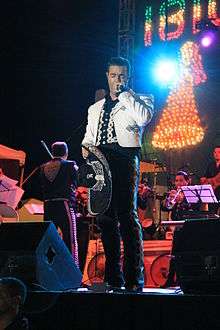
When the 1921 census' results are compared with the results of Mexico's recent censuses[109] as well as with modern genetic research,[160] there is high consistency with respect to the distribution of Indigenous Mexicans across the country, with states located in south and south-eastern Mexico having both the highest percentages of population who self-identify as Indigenous and the highest percentages of Amerindian genetic ancestry. However, this is not the case when it comes to European Mexicans, as there are instances in which states that have been shown through scientific research to have a considerably high European ancestry are reported to have very small white populations in the 1921 census, with the most extreme case being that of the state of Durango, where the aforementioned census asserts that only 0.01% of the state's population (33 persons) self-identified as "white" while modern scientific research shows that the population of Durango has similar genetic frequencies to those found on European peoples (with the state's Indigenous population showing almost no foreign admixture either).[161] Various authors theorize that the reason for these inconsistencies may lie in the Mestizo identity promoted by the Mexican government, which reportedly led to people who are not biologically Mestizos to identify themselves as such.[162][163]
The present day
The following table is a compilation of (when possible) official nationwide surveys conducted by the Mexican government who have attempted to quantify different Mexican ethnic groups. Given that for the most part each ethnic group was estimated by different surveys, with different methodologies and years apart rather than on a single comprehensive racial census, some groups could overlap with others and be overestimated or underestimated.
| Race or ethnicity | Population (est.) | Percentage (est.) | Year |
|---|---|---|---|
| Indigenous | 26,000,000 | 21.5% | 2015[109] |
| Black | 1,400,000 | 1.2% | 2015[109] |
| White | 56,000,000 | 47.0% | 2010[124][125][126] |
| Foreigners residing in Mexico (of any race) | 1,010,000 | <1.0% | 2015[164] |
| East Asian | 1,000,000 | <1.0% | 2010[165] |
| Middle Eastern | 400,000 | <1.0% | 2010[166] |
| Jewish | 68,000 | <1.0% | 2010[167] |
| Muslim | 4,000 | <1.0% | 2015[168] |
| Unclassified (most likely Mestizos) | 37,300,000 | 30.0% | - |
| Total | 123,500,000 | 100% | 2017[169] |
Of all the ethnic groups that have been surveyed, Mestizos are notably absent, which is likely due the label's fluid and subjective definition, which complicates its precise quantification. However it can be safely assumed that Mestizos make up at least the remaining 30% unassessed percentage of Mexico's population with possibilities of increasing if the methodologies of the extant surveys are considered. As example the 2015 intercensal survey considered as Indigenous Mexicans and Afro-Mexicans altogether individuals who self-identified as "part Indigenous" or "part African" thus, said people technically would be Mestizos. Similarly, White Mexicans were quantified based on physical traits and appearance, thus technically a Mestizo with a percentage of Indigenous ancestry that was low enough to not affect his or her primarily European phenotype was considered to be white. Finally the remaining ethnicities, for being of a rather low number or being faiths have more permissive classification criteria, therefore a Mestizo could claim to belong to one of them by practicing the faith, or by having an ancestor who belonged to said ethnicities. Nonetheless, contemporary sociologists and historians agree that, given that the concept of "race" has a psychological foundation rather than a biological one and to society's eyes a Mestizo with a high percentage of European ancestry is considered "white" and a Mestizo with a high percentage of Indigenous ancestry is considered "Indian", a person that identifies with a given ethnic group should be allowed to, even if biologically it doesn't completely belong to that group.[170]
Languages
Languages in Mexico (by percentage):[171]
Spanish is the de facto official language in Mexico being spoken by 98.3% of the population.[172] Mexican Spanish is spoken in a variety of dialects, accents and variations in different regions across the country.
Some indigenous languages are still being spoken by around 5% of Mexicans according to the latest census, in 2003 the General Law of Linguistic Rights of the Indigenous Peoples recognized 68 indigenous languages as "national languages", with the "same validity" in all territories and contexts where they are spoken. The indigenous language with the greatest number of speakers is Nahuatl (1,586,884 speakers in 2010 or 1.5% of the nation's population), followed by Yucatec Maya (796,405 speakers in 2010 0.8%) spoken Yucatán Peninsula, Mixtecas languages (494,454), Tzeltal (474,298), Zapotecas languages (460,683), Tzotzil (429,168), Otomí (288,052), Totonaca (250,252) Mazateco (230,124), Chol (222,051) and 1,462,857 speakers of other languages. After half a century of rural-to-urban migration, in Mexico City and other major cities large districts and sections use both written and spoken Amerindian languages.
During the first half of the 20th century the government promoted a policy of castellanización, that is, promoting the use of Spanish as a way to integrate indigenous peoples into Mexican society. Later, this policy changed, and since the 1980s the government has sponsored bilingual and intercultural education in all indigenous communities. This policy has mainly been successful in large communities with a significant number of speakers. While some languages, with less than 1,000 speakers, are still facing extinction.
The second most spoken language in Mexico, however, is English. It is used extensively at border areas, tourist centers and large metropolitan areas, a phenomenon arguably caused by the economic integration of North American under the North American Free Trade Agreement (NAFTA) and the immigration phenomenon and the return of workers and their families from the United States. In border cities, American TV and radio waves in English (and Spanish) are received as much Spanish-speaking radio and TV stations from Mexico on the US side of the border, thus a bilingual cross-cultural exchange is at work.
Among the languages brought to the country by immigrants are the Venetian of Chipilo, and Mennonite Low German spoken in Durango and Chihuahua. Other languages spoken in Mexico include French, German, Russian, Arabic, Occitan, Catalan, Basque, Galician, Asturian, Chinese, Hebrew, Korean, Ladino, Plautdietsch, Armenian, Italian, etc. Although some of these may have a greater number of speakers than the national languages, they are not recognized by the government.
Mexican nationality and citizenship
The Constitution of Mexico grants Mexican nationality based on birth and naturalization. Mexican laws regarding nationality by birth are very open. Mexican nationality by birth is granted to:[173]
- all those individuals born in Mexican territory,
- all those individuals born outside Mexico, whose father or mother is Mexican by birth,
- all those individuals born outside Mexico, whose father or mother is Mexican by naturalization,
- all those individuals born aboard Mexican aircraft or sea vessels, whether warships or commercial vessels.
Mexican nationality by naturalization is granted to:[173]
- foreign citizens granted Mexican nationality by the Secretariat of Government (Ministry of the Interior);
- foreign citizens married to a Mexican national, whether by birth or naturalization.
Religion
Religion in Mexico (by percentage):[171]
The Mexican population is predominantly Catholic (82.7% of the population aged five and older, according to the 2010 census),[174] although the percentage representing those who attend church on a weekly basis is lower (46%).[175] About 7.6% of the population was classified as Protestant or Evangelical, 2.5% were classified as "Non-Evangelical Biblical" (a classification that groups Adventists, Mormons and Jehovah's Witnesses), 0.05% as practicing Jews, and 4.6% without a religion.[176] The largest group of Protestants are Pentecostals and Charismatics (classified as Neo-Pentecostals).
The states with the highest percentage of professing Catholics are central states, namely Guanajuato (96.4%), Aguascalientes (95.6%) and Jalisco (95.4%), whereas southeastern states have the lowest percentage of Catholics, namely Chiapas (63.8%), Tabasco (70.4%) and Campeche (71.3%).[176] The percentage of professing Catholics has been on the decrease over the last four decades, from over 98% in 1950 to 87.9% in 2000. The average annual growth of Catholic believers from 1990 to 2000 was 1.7% whereas that of non-Catholics was 3.7%.[177] Given that the average annual population increase over the same time period was 1.8%,[178] the percentage of Catholics in relation to the total population continues to be in overall decline.
Unlike some other countries in Latin America or Ibero-America, the 1857 Mexican Constitution drastically separates Church and State. The State does not support or provide any economic resource to the Church (as is the case in Spain and Argentina),[179] and the Church cannot participate in public education (no public school can be operated by a Catholic order, although they can participate in private education). Moreover, the government nationalized all the Church's properties (some of which were given back in the 1990s), and priests lost the right to vote or to be voted for (although in the 1990s they regained the right to vote).
See also
References and notes
- "Encuesta Intercensal 2015" (PDF). INEGI. Retrieved 17 December 2015.
- "The World Factbook — Central Intellgence Agency". Cia.gov. Retrieved 29 August 2017.

- https://www.statista.com/statistics/263748/total-population-of-mexico/
- Statistics on the total population in Mexico, International Monetary Fund. October 2012. Retrieved June 25, 2017.
- La división territorial del Segundo Imperio Mexicano, 1865. Estudios de Historia Moderna y Contemporánea de México, UNAM
- "From Traitors to Heroes: 100 Years of Mexican Migration Policies". Migrationinformation.org. 1 March 2004. Retrieved 29 August 2017.
- "Población total por grupos quinquenales de edad según sexo, 1950 a 2005". Inegi.org.mx. Retrieved 29 August 2017.
- Tasa global de fecundidad, 1976 a 2006
- "Tasa de crecimiento media anual de la población por entidad federativa, 1990 a 2005". Inegi.org.mx. Retrieved 29 August 2017.
- "Tasas de inmigración, emigración y migración neta por entidad federativa, 1995–2000". Inegi.org.mx. Retrieved 29 August 2017.
- "Mexican Immigration to the U.S.: The Latest Estimates". Migrationinformation.org. 1 March 2004. Retrieved 29 August 2017.
- "Census Bureau Summary File" (PDF). Census.gov. Retrieved 29 August 2017.
- Proyecciones de la Población de México 2005–2050 Archived October 12, 2007, at the Wayback Machine
- Hufbauer GC and Schott, JJ, NAFTA Revisited, Institute for International Economics, Washington, D.C. 2005
- Population Division of the Department of Economic and Social Affairs of the United Nations Secretariat, World Population Prospects: The 2012 Revision Archived May 6, 2011, at the Wayback Machine
- "United Nations Statistics Division - Demographic and Social Statistics". unstats.un.org.
- "Instituto Nacional de Estadística y Geografía (INEGI)". Archived from the original on 2012-05-28. Retrieved 2012-05-27.
- "Instituto Nacional de Estadística y Geografía - Temas estadísticos". 3.inegi.org.mx. Retrieved 29 August 2017.
- United nations. Demographic Yearbooks
- "Página no encontrada". 3.inegi.org.mx. Retrieved 29 August 2017.
- "Página no encontrada". 3.inegi.org.mx. Retrieved 29 August 2017.
- "Página no encontrada". 3.inegi.org.mx. Retrieved 29 August 2017.
- "Life expectancy". Our World in Data. Retrieved 2018-08-28.
- Asociaciones de Inmigrantes Extranjeros en la Ciudad de México. Una Mirada a Fines del Siglo XX Archived 2009-07-04 at the Wayback Machine
- Los árabes de México. Asimilación y herencia cultural Archived March 27, 2009, at the Wayback Machine
- Conmemoran 100 años de inmigración coreana Archived January 22, 2010, at the Wayback Machine
- "Migrantes, votos, remesas" (PDF). Ime.gob.mx. Archived from the original (PDF) on 29 July 2016. Retrieved 29 August 2017.
- Argentinos en México Archived February 17, 2007, at Archive.today
- "As Spain's Economy Worsens, Young Adults Flock to Mexico for Jobs - New America Media". newamericamedia.org. Archived from the original on 2013-12-03. Retrieved 2013-11-23.
- Flannery, Nathaniel Parish (2013-04-30). "As Spain Falters, Spaniards Look to Latin America". Forbes. Retrieved 2015-12-26.
- American Citizens Abroad Archived February 25, 2011, at the Wayback Machine
- Retiring Americans, Go south, old man by The Economist
- "Población nacida en otro país residente en México por entidad federativa según sexo, 2000". Inegi.org.mx. Retrieved 29 August 2017.
- "Mexican-Born Population Over Time, 1850-Present". Migration Policy Institute. 2013-08-14.
- "Mexico - Net migration rate - Historical Data Graphs per year". IndexMundi. Retrieved 2019-02-01.
- Mexico-US Migration in: Nafta Revisited by the International Institute of Economics.
-
Martin, Philip. "Nafta Revisited: Mexico-US Migration" (PDF). International Institute of Economics. p. 441. Retrieved 2019-02-01.
The United States unilaterally ended both war-time bracero programs, in part because US labor and civil rights groups argued that the presence of Mexican migrants depressed wages and increased unemployment for similar US workers.
- The Hispanic Population in the United States
- Indicadores seleccionados de la población nacida en México residente en Estados Unidos de América, 1970 a 2000.
- Población emigrante a Estados Unidos de América por entidad federativa según sexo, 2000.
- Distribución porcentual de la población emigrante a Estados Unidos de América por tamaño de la localidad de residencia para cada sexo, 1990 a 1995 y 1995 a 2000.
- "Población migrante de retorno de Estados Unidos de América por entidad federativa según sexo, 2000". Inegi.org.mx. Retrieved 29 August 2017.
- Lizette Alvarez (20 December 2006). "A Growing Stream of Illegal Immigrants Choose to Remain Despite the Risks". New York Times. Retrieved 15 January 2013.
- "Archived copy". Archived from the original on 2015-05-01. Retrieved 2016-04-19.CS1 maint: archived copy as title (link)
- "Navarrette: The Mexican reverse migration". Newsday.com. Retrieved 29 August 2017.
- "Mexicans feeling persecuted flee U.S. - CNN.com". CNN. November 27, 2012.
- "L.A. Now". Los Angeles Times. October 23, 2012.
- Preston, Julia (July 31, 2008). "Decline Seen in Numbers of People Here Illegally". The New York Times. Retrieved May 5, 2010.
- Passel, Jeffrey S.; Cohn, D'Vera; Gonzalez-Barrera, Ana (23 April 2012). "Net Migration from Mexico Falls to Zero—and Perhaps Less". Pewhispanic.org. Retrieved 29 August 2017.
- "In 1637 the military force maintained in the islands consisted of one thousand seven hundred and two Spaniards and one hundred and forty Indians." ~Memorial de D. Juan Grau y Monfalcon, Procurador General de las Islas Filipinas, Docs. Inéditos del Archivo de Indias, vi, p. 425. "In 1787 the garrison at Manila consisted of one regiment of Mexicans comprising one thousand three hundred men, two artillery companies of eighty men each, three cavalry companies of fifty men each." La Pérouse, ii, p. 368.
- Mexicans in the World (Spanish Wikipedia)
- "Pew Research; How the US Hispanic Population is Changing". www.pewresearch.org. Retrieved 5 November 2018.
- "Ethno-Cultural Portrait of Canada, Table 1". 12.statcan.ca. Retrieved 29 August 2017.
- "Mexicanos en España INE 2007". Ine.es. Archived from the original on 2012-02-19. Retrieved 29 August 2017.
- |N|M%C9XICO
- Bolivia - Censo de Población y Vivienda 2001 Archived 2008-10-14 at the Wayback Machine
- Statische Bundesamt Deutschland Archived November 16, 2010, at the Wayback Machine
- "Página/12". Pagina12.com.ar. Retrieved 29 August 2017.
- "SBS Australia". SBS. Archived from the original on 22 March 2019. Retrieved 10 September 2019.
- "Investigación de la Migración Internacional en Israel" (PDF). 1.cbs.gov.il. Archived from the original (PDF) on 15 October 2013. Retrieved 29 August 2017.
- "Statistiche demografiche ISTAT". Demo.istat.it. Retrieved 29 August 2017.
- INE Archived September 27, 2011, at the Wayback Machine
- "Raza Cósmica". Razacosmica.blogspot.com. Retrieved 29 August 2017.
- "Redatam::CELADE, ECLAC - United Nations". Celade.cepal.org. 28 June 2012. Retrieved 29 August 2017.
- "Redatam::CELADE, ECLAC - United Nations". Celade.cepal.org. 30 June 2012. Retrieved 29 August 2017.
- "Censo de Población y Vivienda 2000 - Jerarquía Censal". Celade.cepal.org. Archived from the original on 2010-03-06. Retrieved 29 August 2017.
- Colombia - Sistema de Consulta Información Censal (Censo 2005) Archived June 16, 2013, at the Wayback Machine
- "R+::CEPAL/CELADE - R+SP WebServer". Espino.ine.cl. 28 June 2012. Retrieved 29 August 2017.
- "Redatam::CELADE, ECLAC - United Nations". Celade.cepal.org. Archived from the original on 26 October 2007. Retrieved 29 August 2017.
- "II Conteo de población y vivienda 2005". Inegi.org.mx. Retrieved 29 August 2017.
- CONAPO Áreas Metropolitanas Archived 2011-05-01 at the Wayback Machine
- "Síntesis de resultados 2005". Inegi.org.mx. Retrieved 29 August 2017.
- "Delimitación de las zonas metropolitanas de México 2015" (PDF). INEGI. 2015. Retrieved June 5, 2020.
- Wang, S; Ray, N; Rojas, W; et al. (2008-03-21). "Geographic Patterns of Genome Admixture in Latin American Mestizos". PLOS Genetics. 4 (3): e1000037. doi:10.1371/journal.pgen.1000037. PMC 2265669. PMID 18369456.
- Ruiz-Linares et al (2014). «Admixture in Latin America: Geographic Structure, Phenotypic Diversity and Self-Perception of Ancestry Based on 7,342 Individuals». University College de Londres
- Ruiz-Linares, Andrés; et al. (25 September 2014). "Admixture in Latin America: Geographic Structure, Phenotypic Diversity and Self-Perception of Ancestry Based on 7,342 Individuals". PLoS Genetics. 10 (9): e1004572. doi:10.1371/journal.pgen.1004572.
- "Mexico Population 2019", World Population Review
- "World Factbook SOUTH AMERICA : Mexico", The World Factbook, July 12, 2018
- "censo General de la Republica Mexicana 1895" Archived 2017-08-10 at the Wayback Machine, “INEGI”, Mexico, Retrieved on 24 July 2017.
- Wade (1981:32)
- Knight (1990:78–85)
- "Composición Étnica de las Tres Áreas Culturales del Continente Americano al Comienzo del Siglo XXI" (PDF). Academic investigation (in Spanish). University of the State of Mexico. 2005. Archived from the original (PDF) on 22 October 2013. Retrieved 10 June 2014.
- Bartolomé, Miguel Alberto (1996). "Pluralismo cultural y redefinicion del estado en México". in Coloquio sobre derechos indígenas" (PDF). Oaxaca: IOC. p. 2.
En primer lugar cabe destacar que en México la pertenencia racial no es un indicador relevante ni suficiente para denotar una adscripción étnica específica. [...] Por lo tanto es relativamente factible realizar el llamado tránsito étnico, es decir que un indígena puede llegar a incorporarse al sector mestizo a través de la renuncia a su cultura tradicional y si sus condiciones materiales se lo permiten.
- Knight, Alan (1 September 2010). "The Idea of Race in Latin America, 1870–1940". In Richard Graham (ed.). The Idea of Race in Latin America: 1870-1940. University of Texas Press. p. 73. ISBN 978-0-292-78888-6. Retrieved 17 July 2013.
- Schaefer, Richard T. (ed.) (2008). Encyclopedia of Race, Ethnicity and Society. Sage. p. 900. ISBN 978-1-4129-2694-2.
In New Spain, there was no strict idea of race (something that continued in Mexico). The Indians that had lost their connections with their communities and had adopted different cultural elements could "pass" and be considered mestizos. The same applied to Blacks and castas.
CS1 maint: extra text: authors list (link) - Wade, Peter (20 May 1997). Race And Ethnicity In Latin America. Pluto Press. ISBN 978-0-7453-0987-3. Retrieved 17 July 2013.
- Bartolomé (1996:2)
- Wade (1997:44–47)
- "Mexico- Ethnic groups". Encyclopædia Britannica. Retrieved 1 October 2016.
- en el censo de 1930 el gobierno mexicano dejó de clasificar a la población del país en tres categorías raciales, blanco, mestizo e indígena, y adoptó una nueva clasificación étnica que distinguía a los hablantes de lenguas indígenas del resto de la población, es decir de los hablantes de español. Archived 2013-08-23 at the Wayback Machine
- Gonzalo Aguirre-Beltran (1972). La población negra de México: estudio etnohistórico. Fondo de Cultura Económica. p. 267. ISBN 9789681609122. Retrieved March 13, 2019.
- Michael Werner (2001). Concise Encyclopedia of Mexico. Routledge. p. 117. ISBN 9781135973773. Retrieved March 13, 2019.
- "Racismo, falso mestizaje y desigualdad social en México", Revista Cuadrivio, 2016, Retrieved on March 13, 2019.
- "México sin mestizaje: una reinterpretación de nuestra historia", UNAM, 2016, Retrieved on March 13, 2019.
- Sherburne Friend Cook; Woodrow Borah (1998). Ensayos sobre historia de la población. México y el Caribe 2. Siglo XXI. p. 188. ISBN 9789682301063. Retrieved March 13, 2019.
- Sherburne Friend Cook; Woodrow Borah (1998). Ensayos sobre historia de la población. México y el Caribe 2. Siglo XXI. p. 197. ISBN 9789682301063. Retrieved March 13, 2019.
- David A. Branding; Woodrow Borah (1975). Mineros y comerciantes en el México borbónico (1763-1810). Fondo de Cultura Económica. p. 156. ISBN 9789681613402. Retrieved January 27, 2018.
- Gloria M. Delgado de Cantú (2004). Historia de Mexico, Legado Historico Y Pasado Reciente. Pearson Educación. p. 99. ISBN 9702605237. Retrieved March 13, 2019.
- Knight (1990:75)
- Friedlander, Judith. 1975. Being Indian in Hueyapan: A Study of Forced Identity in Contemporary Mexico. New York: Saint Martin's Press.
- Bartolomé, Miguel Alberto. (1996) "Pluralismo cultural y redefinicion del estado en México". in Coloquio sobre derechos indígenas, Oaxaca, IOC. p.5)
- "Indicadores seleccionados sobre la población hablante de lengua indígena, 1950 a 2005". Inegi.gob.mx. Archived from the original on 18 January 2012. Retrieved 10 December 2011.
- Knight (1990:73-74)
- Bartolomé (1996:3-4)
- "Síntesis de Resultados" (PDF). Comisión Nacional para el Desarrollo de los Pueblos Indígenas. 2006. Retrieved 22 December 2010.
- Defined as persons who live in a household where an indigenous language is spoken by one of the adult family members, and or people who self identified as indigenous ("Criteria del hogar: De esta manera, se establece, que los hogares indígenas son aquellos en donde el jefe y/o el cónyuge y/o padre o madre del jefe y/o suegro o suegra del jefe hablan una lengua indígena y también aquellos que declararon pertenecer a un grupo indígena.")AND persons who speak an indigenous language but who do not live in such a household (Por lo antes mencionado, la Comisión Nacional Para el Desarrollo de los Pueblos Indígenas de México (CDI) considera población indígena (PI) a todas las personas que forman parte de un hogar indígena, donde el jefe(a) del hogar, su cónyuge y/o alguno de los ascendientes (madre o padre, madrastra o padrastro, abuelo(a), bisabuelo(a), tatarabuelo(a), suegro(a)) declaro ser hablante de lengua indígena. Además, también incluye a personas que declararon hablar alguna lengua indígena y que no forman parte de estos hogares )
- "Encuesta Intercensal 2015" Archived 2017-04-22 at the Wayback Machine, “INEGI”, Mexico, December 2015. Retrieved on 28 April 2017.
- "Mexico - History, Geography, Facts, & Points of Interest". Britannica.com. Retrieved 29 August 2017.
- "POBLACIÓN DE 5 AÑOS Y MÁS POR ENTIDAD FEDERATIVA, SEXO Y GRUPOS LENGUA INDÍGENA QUINQUENALES DE EDAD, Y SU DISTRIBUCIÓN SEGÚN CONDICIÓN DE HABLA INDÍGENA Y HABLA ESPAÑOLA" (PDF). INEGI, México. Archived from the original (PDF) on 2008-01-02. Retrieved 2007-12-13.
- "Comision Nacional Para el Desarrollo de los Pueblos Indigenas - México". Cdi.gob.mx. Retrieved 29 August 2017.
- en el año de 1808 aproximadamente el 60% de la población de lo que sería México pertenecía a la categoría étnica de indígena, el 18% eran europeos o de origen europeo (de los cuales la inmensa mayoría eran criollos nacidos en México) Archived 23 August 2013 at the Wayback Machine.
- Sherburne Friend Cook; Woodrow Borah (1998). Ensayos sobre historia de la población. México y el Caribe 2. Siglo XXI. p. 223. ISBN 9789682301063. Retrieved 12 September 2017.
- "Household Mobility and Persistence in Guadalajara, Mexico: 1811–1842, page 62", fsu org, 8 December 2016. Retrieved on 9 December 2018.
- "Ser mestizo en la nueva España a fines del siglo XVIII. Acatzingo, 1792", Scielo, Jujuy, November 2000. Retrieved on 1 July 2017.
- "The World Factbook: North America: Mexico: People and Society". The World Factbook, Central Intelligence Agency (CIA). Retrieved August 23, 2017.
mestizo (Amerindian-Spanish) 62%, predominantly Amerindian 21%, Amerindian 7%, other 10% (mostly European)
- "Encyclopedia Britannica: Mexico Ethnic groups".
- Federico Navarrete (2016). Mexico Racista. Penguin Random house Grupo Editorial Mexico. p. 86. ISBN 9786073143646. Retrieved February 23, 2018.
- "Racismo y salud mental en estudiantes universitarios en la Ciudad de México", Scielo, Cuernavaca, April–March 2011. Retrieved on 28 April 2017.
- "Stratification by Skin Color in Contemporary Mexico", Jstor org, available creating a free account , Retrieved on 27 January 2018.
- "Admixture in Latin America: Geographic Structure, Phenotypic Diversity and Self-Perception of Ancestry Based on 7,342 Individuals" table 1, Plosgenetics, 25 September 2014. Retrieved on 9 May 2017.
- "21 de Marzo Día Internacional de la Eliminación de la Discriminación Racial" pag.7 Archived 2017-05-25 at the Wayback Machine, CONAPRED, Mexico, 21 March. Retrieved on 28 April 2017.
- "Encuesta Nacional Sobre Discriminación en Mexico” Archived 2012-11-08 at the Wayback Machine, “CONAPRED”, Mexico DF, June 2011. Retrieved on 28 April 2017.
- "DOCUMENTO INFORMATIVO SOBRE DISCRIMINACIÓN RACIAL EN MÉXICO" Archived 2017-05-25 at the Wayback Machine, CONAPRED, Mexico, 21 March 2011, retrieved on 28 April 2017.
- " Visión INEGI 2021 Dr. Julio Santaella Castell", INEGI, 03 July 2017, Retrieved on 30 April 2018.
- "Resultados del Modulo de Movilidad Social Intergeneracional" Archived 2018-07-09 at the Wayback Machine, INEGI, 16 June 2017, Retrieved on 30 April 2018.
- "Alteraciones cutáneas del neonato en dos grupos de población de México", Scielo, March/April 2005. Retrieved on 18 May 2017.
- Miller (1999). Nursing Care of Older Adults: Theory and Practice (3, illustrated ed.). Lippincott Williams & Wilkins. p. 90. ISBN 978-0781720762. Retrieved 17 May 2014.
- "Congenital Dermal Melanocytosis (Mongolian Spot): Background, Pathophysiology, Epidemiology". EMedicine.medscape.com. 7 January 2017. Retrieved 8 October 2017.
- Lawrence C. Parish; Larry E. Millikan, eds. (2012). Global Dermatology: Diagnosis and Management According to Geography, Climate, and Culture. M. Amer, R.A.C. Graham-Brown, S.N. Klaus, J.L. Pace. Springer Science & Business Media. p. 197. ISBN 978-1461226147. Retrieved 17 May 2014.
- "About Mongolian Spot". tokyo-med.ac.jp. Archived from the original on 8 December 2008. Retrieved 1 October 2015.
- "Tienen manchas mongólicas 50% de bebés" Archived 2020-06-01 at the Wayback Machine, El Universal, January 2012. Retrieved on 3 July 2017.
- Howard F. Cline (1963). THE UNITED STATES AND MEXICO. Harvard University Press. p. 104. ISBN 9780674497061. Retrieved May 18, 2017.
- . Los-indios-barbaros-de.html
- "HISTORY TV Schedule - HISTORY". Historyenespanol.com. Retrieved 29 August 2017.
- Los Extranjeros en México, La inmigración y el gobierno ¿Tolerancia o intolerancia religiosa? Archived 2009-03-27 at the Wayback Machine
- Gitlitz, David (27 August 1998). "Nexos entre los cripto-judíos coloniales y contemporáneos". Revista de Humanidades: Tecnológico de Monterrey (5): 187–212.
- "HugeDomains.com - PuroChihuahua.com is for sale (Puro Chihuahua)". Purochihuahua.com.
- Montagner, Eduardo. "El dialecto veneto de Chipilo". Orbilat.com. Archived from the original on 2011-06-06. Retrieved 2007-04-03.
- García Ita, Rosa E. "Los árabes de México. Asimilación y herencia cultural" [The Arabs of Mexico. Assimilation & cultural heritage] (PDF). confines.mty.itesm.mx. Campus Monterrey. Archived from the original (PDF) on 27 March 2009. Retrieved 17 April 2010.
- "Archived copy" (PDF). Archived from the original (PDF) on 27 March 2009. Retrieved 17 April 2010.CS1 maint: archived copy as title (link)
- "Arab Influence in Yucatecan Cuisine – Mexico Culture – Arab Influence in Yucatecan Cuisine, Culture". Discoverymexico.com. 16 March 2008. Archived from the original on 16 March 2008. Retrieved 29 August 2017.
- "Find Local Contractors - Home Remodeling Contractors on Ecnext". goliath.ecnext.com.
- https://joshuaproject.net/people_groups/14567/MX
- Vincent, Theodore G (2001). The Legacy of Vicente Guerrero, Mexico's First Black Indian President. University Press of Florida. ISBN 978-0-8130-2422-6.
- Tatiana Seijas (2014). Asian Slaves in Colonial Mexico: From Chinos to Indian. Cambridge University Press. p. 21. ISBN 9781107063129.
- Leslie Bethell (1984). Leslie Bethell (ed.). The Cambridge History of Latin America. Volume 2 of The Cambridge History of Latin America: Colonial Latin America. I-II (illustrated, reprint ed.). Cambridge University Press. p. 21. ISBN 978-0521245166.
- Ignacio López-Calvo (2013). The Affinity of the Eye: Writing Nikkei in Peru. Fernando Iwasaki. University of Arizona Press. p. 134. ISBN 978-0816599875.
- Dirk Hoerder (2002). Cultures in Contact: World Migrations in the Second Millennium. Andrew Gordon, Alexander Keyssar, Daniel James. Duke University Press. p. 200. ISBN 978-0822384076.
- Buchenau, Jürgen (Spring 2001). "Small Numbers, Great Impact: Mexico and Its Immigrants, 1821-1973" (PDF). Journal of American Ethnic History. 20 (3): 35.
- "Consideraciones sobre la población de la Nueva España (1793-1810)" Archived 2017-07-31 at the Wayback Machine, El Colegio de Mexico, Mexico, Retrieved on 24 July 2017.
- Historical Dictionary of Argentina. London: Scarecrow Press, 1978. pp. 239–40.
- "American Indians in the Federal Decennial Census", Retrieved on 25 July 2017.
- Central Intelligence Agency (CIA). "North America: Mexico". The World Factbook. Ethnic groups. Retrieved 11 April 2014.
mestizo (Amerindian-Spanish) 60%, Amerindian or predominantly Amerindian 30%, white 9%, other 1%
- "El mestizaje es un mito, la identidad cultural sí importa" Istmo, Mexico, Retrieved on 25 July 2017.
- "Más desindianización que mestizaje. Una relectura de los censos generales de población" Archived 2017-07-31 at the Wayback Machine INAH, Mexico, Retrieved on 25 July 2017.
- DEPARTAMENTO DE LA ESTADISTICA NACIONAL Archived 4 March 2016 at the Wayback Machine CENSO GENERAL DE HABITANTES 1921 Census (Page: 62)
- "El impacto del mestizaje en México", “Investigación y Ciencia”, Spain, October 2013. Retrieved on 01 June 2017.
- Sosa-Macías, Martha (2006). "CYP2D6Genotype and Phenotype in Amerindians of Tepehuano Origin and Mestizos of Durango, Mexico". The Journal of Clinical Pharmacology. 46 (5): 527–536. doi:10.1177/0091270006287586. PMID 16638736.
- "Composición Étnica de las Tres Áreas Culturales del Continente Americano al Comienzo del Siglo XXI" (PDF). Academic investigation (in Spanish). University of the State of Mexico. 2005. p. 196. Archived from the original (PDF) on 22 October 2013. Retrieved 10 June 2014.
- El mestizaje y las culturas regionales Archived 23 August 2013 at the Wayback Machine.
- "Principales resultados de la Encuesta Intercensal 2015 Estados Unidos Mexicanos" (PDF). INEGI. p. 1. Archived from the original (PDF) on 10 December 2015. Retrieved 9 December 2015.
- "La Música de Guerrero (Del atabal a la flauta, el son y el zapateado)". Gobierno del Estado de Guerrero. Archived from the original on 2015-02-20. Retrieved 20 February 2015.
- "Archived copy" (PDF). Archived from the original (PDF) on 2009-03-27. Retrieved 2010-04-17.CS1 maint: archived copy as title (link)
- "Panorama de las religiones en México 2010" (PDF) (in Spanish). INEGI. p. 3. Archived from the original (PDF) on 21 October 2015. Retrieved 2 March 2015.
- "El número de católicos en México v a la baja; aumentan los ateos y de otras religiones", “Animal político”, Mexico, February 2016. Retrieved on 03 August 2017.
- "Mexico cuenta con 123.5 millones de habitantes", Retrieved on 26 July 2017.
- "El mestizaje en Mexico" (PDF). Archived from the original (PDF) on 2017-08-01. Retrieved 2017-08-03.
- "North America :: MEXICO". CIA The World Factbook. Retrieved 29 August 2017.
- "Encuesta Intercensal 2015" (PDF). INEGI, México.
- Artículo 30 Archived 2008-01-03 at the Wayback Machine. Constitución Política de los Estados Unidos Mexicanos.
- "Volumen y porcentaje de la población según profese alguna religión y tipo de religión, 1895 a 2010". Inegi.org.mx. Retrieved 29 August 2017.
- "Church attendance in Latin America". Archived from the original on 2006-09-01. Retrieved 2017-07-26.
- Población de 5 años y más por entidad federativa, sexo y religión y su distribución según grupos quinquenales de edad Archived September 25, 2007, at the Wayback Machine.
- "Tasa de crecimiento media anual de la población según credo religioso para cada período decenal, 1950 a 2000". Inegi.org.mx. Retrieved 29 August 2017.
- "Tasa de crecimiento media anual de la población, 1950 a 2005". Inegi.org.mx. Retrieved 29 August 2017.
- "Argentina: Constitución de 1994". pdba.georgetown.edu.
.jpg)



